
04
Sep
(Beyond Pesticides, September 4, 2013) More than a decade after Latino parents filed a civil rights complaint with the U.S. Environmental Protection Agency (EPA) detailing the dangerous levels of pesticides at Latino public schools throughout California, the parents are suing the agency for its continuing failure to protect Latino  students. The schools are near crop fields where methyl bromide and other fumigants are sprayed. In August 2011, EPA found that California’s Latino school children suffer disproportionately from exposure to pesticides due to spraying near their schools, but EPA has yet to remedy these exposures.

In attempts to finally force EPA to protect civil rights of hundreds of Latino children, Center on Race, Poverty and the Environment (CRPE), California Rural Legal Assistance Inc., Farmworker Justice, and The City Project filed a lawsuit on behalf of the original plaintiffs, the Garcia family, and multiple generations of Latino school children who still do not have substantive protection from the EPA. In 1999, the Garcia family alleged that their children and other Latino children were being exposed to dangerous levels of pesticides at their public schools, which are directly adjacent to several strawberry fields where methyl bromide and other fumigants are sprayed. The complaint was filed under Title VI of the Civil Rights Act of 1964 , which prohibits intentional discrimination and discriminatory effects on the basis of race, color, and national origin by recipients of federal financial assistance. The complaint alleged that the California Department of Pesticide Regulationâs (CDPR) annual renewal of the registration of methyl bromide in 1999 discriminated against Latino school children based on the health impacts of this pesticide. Concerns were raised that there was an unintentional adverse and disparate impact on Latino children resulting from the use of methyl bromide during that period. This concern was based on the high percentage of Latino children in schools near fields where methyl bromide was applied.
In 2011, the EPA issued the first ever preliminary findings of racial discrimination based on Garciaâs claims. EPA then entered into secret negotiations without the Garcias and issued a settlement that does not remedy the discrimination suffered. As part of the negotiations, EPA and CDPR agreed to expand on-going monitoring of methyl bromide air concentrations by agreeing to monitor at or near one of the schools named in the original complaint. However, according to this new suit, EPA failed and continues to fail to protect the Garciasâ rights to freedom from racial discrimination, noting that CDPRâs measures fall short of actually providing relief to the children and their parents who were affected by the use of methyl bromide.
âI will keep fighting for my family,â said Maria Garcia, a mother and grandmother, as the lawsuit was filed. This discrimination has gone on so long that Mariaâs son who participated in the original suit as a high school student is now a father with two children who will attend the same polluted schools he did. Â These schools, like many other schools in California with high concentrations of Latino students, continue to face dangerous levels of pesticide exposure.
Remarkably, the Garcias continue to dream for justice for their children and Latino children throughout California. Their complaint challenges the EPAâs Civil Rights Act regulations and if successful the lawsuit has the potential to allow other people of color across the country more access to protections from racial discrimination. Most importantly, it will formally recognize that a healthy environment is not a luxury but a civil right.
Recently, CDPR announced that it detected the highly toxic pesticide chlorpyrifos in nearly 30% of air tests that are being conducted in three high risk communities surrounded by intensive agriculture. The state runs tests for air particles from methyl bromide and 32 other pesticides and breakdown products, and measures the results against screening levels established by CDPR. However, critics maintain that the stateâs sampling is not representative of peak agricultural exposures and question whether any level of a toxicant in air is reasonable under the law, given the viability of alternative agricultural practices that do not rely on these chemicals. Pesticides can drift and volatilize, and move over long distances fairly rapidly through wind and rain. Documented exposure patterns result from drift cause particular concerns for children and other sensitive population groups. Adverse health effects, such as nausea, dizziness, respiratory problems, headaches, rashes, and mental disorientation, may appear even when a pesticide is applied according to label directions.
Meanwhile, farmworkers and their families gathered on Capitol Hill this summer to meet with their members of Congress to urge for stronger protections for farmworkers from hazardous pesticides. As a result of cumulative long-term exposures, farmworkers and their children, who often times also work on the farm or live nearby, are at risk of developing serious chronic health problems such as cancer, neurological impairments and Parkinsonâs disease. In testimony on Capitol Hill, Occupational and Environmental Health Director of Farmworker Justice Virginia Ruiz painted a grim picture of the conditions farmworkers and their families face. She stated, âThe close proximity of agricultural fields to residential areas and schools makes it nearly impossible for farmworkers and their families to escape exposure because pesticides are in the air they breathe and the food they eat, and the soil where they work and play.â She noted the heartbreaking point that, in order to minimize exposure, farmworkers are told not to hug their children when they come home from work â they must first remove their clothes, and take a shower.
An estimated 5.1 billion pounds of pesticides are applied to crops annually in the U.S., and farmworkers face the greatest threat from these chemicals than any other sector of society, with thousands of farmworkers each year experiencing pesticide poisoning. The best way for consumers to prevent use  of hazardous fumigants and other pesticides is to buy organically produced food. Support organic farming and protect farmers, farmworkers, and their families and neighbors from toxic chemicals. Organic agriculture does not allow the use of the chemicals cited in the lawsuit as well as toxic chemicals that have been shown to drift and cause a myriad of chronic health effects, such as cancer, endocrine disruption and a series of degenerative diseases like Parkinsonâs disease.
Beyond Pesticides recently updated the Eating with a Conscience database to reflect the risk conventional produce poses to farmworker health. For more information on how organic is the right choice for both consumers and the farmworkers that grow our food, see Beyond Pesticides webpage, Health Benefits of Organic Agriculture.
Sources:
Center for Race, Poverty and the Environment Â
Treehugger
Posted in Agriculture, Chemicals, Children/Schools, Environmental Justice, methyl bromide, Pesticide Drift by: Beyond Pesticides
No Comments
03
Sep
(Beyond Pesticides, September 3, 2013) For the past several years, corn rootworms  have  been widely reported to exhibit resistance  to corn genetically engineered (GE) with the Bacillus thuringiensis (Bt) toxin. A  new report by  University of Illinois researchers found the resistant corn rootworm  in two of the stateâs counties significantly damaged by western corn rootworm. The increasing lack of efficacy of GE corn, developed with the claim that it  is specifically designed to protect corn from rootworm, calls into question the efforts of agrichemical companies to patent new forms of GE crops.
 The report by Joe Spencer, PhD, and Michael Gray, PhD,  identifies significant damage from western corn rootworms in farm field that were planted with GE corn that contain a Bt protein referred to as âCry3Bb1,â which has been inserted into nearly one-third of the corn planted in the United States. This version of Bt corn was introduced by Monsanto in 2003, and was touted as a way to reduce insecticide use against rootworm pests. Evidence was gathered in two Illinois counties, Livingston and Kankakee, after fields that had severe root pruning and lodging were brought to the attention of Drs. Spencer and Gray. Dr. Gray was quoted in a Reuters article stating,”Farmers across âËa wide swath of Illinoisâ could face formidable challenges protecting corn crops.â
The report by Joe Spencer, PhD, and Michael Gray, PhD,  identifies significant damage from western corn rootworms in farm field that were planted with GE corn that contain a Bt protein referred to as âCry3Bb1,â which has been inserted into nearly one-third of the corn planted in the United States. This version of Bt corn was introduced by Monsanto in 2003, and was touted as a way to reduce insecticide use against rootworm pests. Evidence was gathered in two Illinois counties, Livingston and Kankakee, after fields that had severe root pruning and lodging were brought to the attention of Drs. Spencer and Gray. Dr. Gray was quoted in a Reuters article stating,”Farmers across âËa wide swath of Illinoisâ could face formidable challenges protecting corn crops.â
Even more problematic is that western corn rootworms also appear to be resistant to crop rotation. The crop damage was found in fields where the GE corn had been planted in a rotation following soybeans. Rootworms were also collected in the adjacent soybean fields. The report found the number of adult rootworm beetles in the soybean field was reminiscent of densities in the late 1990’s and early 2000’s. According to Dr. Spencer, âIt looked like continuous corn and use of the same trait year after year is what produced resistant beetles. Growers thought their get-out-of-jail-free card was just to rotate to soybeans. But what we’re seeing in northeast and east-central Illinois are beetles that are also resistant to crop rotation.â
Western corn rootworm, along with northern corn rootworm, are the two species of rootworm that may cause severe damage to corn as both larvae and adults. Southern corn rootworms can cause damage to corn leaves, but because they cannot overwinter in most areas of the Midwest their larvae do not pose a major threat to Midwestern corn production. Western corn rootworms deposit their eggs in the soil from midsummer to autumn and the eggs begin hatching in late May and early June. Western corn rootworm larvae feed on the roots of corn plants, inhibiting the plantâs ability to absorb moisture and nutrients, while opening a pathway for attack from soil-borne pathogens. The agricultural chemicals bifenthrin, carbaryl, chlorpyrifos, cyfluthrin, and deltamethrin are commonly used insecticides to control for western corn rootworm. As western corn rootworms have become resistant to Bt corn, farmers have begun to rely more heavily on chemical methods.
Corn rootworm resistance to Bt corn has been widely reported for the past several years. A January 17, 2013  release from the Environmental Protection Agency (EPA) concluded that âcorn rootworm may not be completely controlled by Cry3Bb1 in certain parts of the corn belt.â In 2011, entomologists at Iowa State University  published a study  verifying the first field-evolved resistance of corn rootworm to a Bt toxin. The researchers documented resistance to the Bt toxin Cry3Bb1. The study found the western rootwormâs ability to adapt was strongest in fields where Bt corn was planted for three consecutive years and suggested that insufficient planting of refuges may have contributed to the resistance. This study was cited by a group of 22 prominent entomologists who submitted formal comments to the EPA on their concerns of the viability of Cry3Bb1 corn. Recent research also shows that the cultivation of Bt corn has negative impacts on beneficial soil life.
In their report, Drs. Gray and Spencer recommend that, âProducers in the most severely affected areas (central and east central) of Illinois should consider the use of pyramided Bt hybrids (hybrids expressing more than one rootworm Cry protein) in 2014.â However, pyramided or stacked GE corn varieties have also been  shown to be ineffective. A University of Arizona College of Agriculture and Life Sciences study, published in the Journal PNAS, found that insects that were bred to be resistant to one form of Bt toxin were often cross-resistant to other forms of Bt toxin.
As insects and weeds become resistant to GE crops and the herbicides the crops are engineered to  resist, agrichemical companies are working to introduce a new generation of GE crops. The  St. Louis Pots-Dispatch  reported in 2012 on progress that multinational chemical corporations Dow AgroSciences, BASF, and Monsanto are making to bring multi-herbicide resistant varieties to market. Under separate arrangements with each company, Monsanto adds glyphosate resistance to seeds that are simultaneously engineered to resist other herbicides. In October 2012, Dow AgroSciences obtained a  global patent  on its Enlist Duo technology, which packages an herbicide containing 2, 4-D and glyphosate with seeds engineered to tolerate both materials. Monsanto has also been partnering with BASF on  dicamba  and glyphosate tolerant crop varieties since 2009 with a focus on soybeans, cotton, and corn.
The report by Drs. Gray and Spencer, though important for showing increased rootworm resistance to Bt corn, makes unsustainable recommendations to farmers that they use pyramided Bt hybrids or âplanting-time soil insecticidesâ to reduce western corn rootworm in 2014. A sustainable solution to rootworm resistance is the transition to organic agriculture. Organic agriculture is an ecologically-based management system that prioritizes cultural, biological, and mechanical production practices and natural inputs by strengthening on-farm resources, such as soil fertility, pasture and biodiversity. Â For more reasons to support organic agriculture, visit Beyond Pesticidesâ Why Organic page.
Source: Reuters
All unattributed positions and opinions in this piece are those of Beyond Pesticides.
Posted in Agriculture, Bt, Chemicals, corn rootworm, Corporations, Genetic Engineering, Indiana, Monsanto, Pests, Resistance, State/Local by: Beyond Pesticides
No Comments
30
Aug
(Beyond Pesticides, August 30, 2013) Months after Central American health ministries issued a  joint declaration citing kidney disease as a top public health priority, the World Bank just approved a new loan to expand sugar cane plantations in Nicaragua. The Bank’s loan represents renewed support for an industry whose workers have been devastated by the disease, which has increasingly been linked to pesticide exposure and exacerbated by heat stress. Kidney disease afflicts agricultural workers in sugar cane fields, killing thousands each year in Central America as well as in Sri Lanka and India.
Scientists have yet to definitively uncover the cause of chronic kidney disease (CKD), although emerging research points to toxic heavy metals contained in pesticides as one of the primary culprits. CKD is a condition characterized by a gradual loss of kidney function and is often lethal for poor agricultural workers. As the kidneys begin to fail, wastes can build in the blood causing complications such as high blood pressure, anemia, weak bones, poor nutritional health and nerve damage. Several published studies demonstrate that exposure to certain  organochlorine pesticide products and their heavy metal contaminants used on sugar cane plantations are causally linked to CKD.
pesticides as one of the primary culprits. CKD is a condition characterized by a gradual loss of kidney function and is often lethal for poor agricultural workers. As the kidneys begin to fail, wastes can build in the blood causing complications such as high blood pressure, anemia, weak bones, poor nutritional health and nerve damage. Several published studies demonstrate that exposure to certain  organochlorine pesticide products and their heavy metal contaminants used on sugar cane plantations are causally linked to CKD.
The recent joint declaration formally recognized the disease and its unique characteristics, with several of the regionâs health ministries pledging meaningful new steps, including more detailed statistical tracking of CKD, the development of national and regional plans to investigate and treat the disease, and promotion of stronger regulation of pesticides. However, the approval of the new $15 million loan from the World Bank signals a disregard of the growing issue of CKD that plagues rural Central America and the efforts of these governments to tackle this public health problem.
Despite mounting  scientific evidence linking pesticide exposure to CKD, the World Bank approved the loan, stating in its environmental and social review that there is no proof that CKD is linked to sugarcane work. âDisease epidemiology and an alleged connection between sugar industries in general have previously been investigated through studies requested by the IFC Compliance Advisor Ombudsman,â stated the IFCâs review documents. âNo direct relationship between the sugar sector and the disease has been established.â
The loan was provided by the private sector lending arm of the World Bankââthe International Finance Corporation (IFC)ââand will go toward expanding the Montelimar sugar cane plantation in western Nicaragua. The last year IFC provided Nicaragua with loans for sugar cane plantations was in 2006. At that time, farmworkers afflicted with CKD filed a formal complaint with the IFC ombudsman, charging that the loan did not consider the threats of the epidemic to farmworkers, in direct violation of the Bankâs requirements for a thorough environmental and social review.
The World Bankâs assessment relies on a Boston University  study,  which found, after studying workers over one six-month harvest season in Nicaragua, that the causes of CKD were still unclear. However, lead scientist of the study Daniel Brooks, PhD. said that, while the Bankâs assessment is technically accurate, it completely mischaracterizes the significance of the findings. âWhat I wouldnât say there is that thereâs no direct link and what I wouldnât say is that the evidence is most consistent with no link,â Dr. Brooks said. âItâs pretty much the consensus of researchers in the region that heat stress and these occupational exposures are most likely to be playing a role.â
These concerns are backed by the Council of Health Ministers of Central America, which agreed in its declaration that, Â âThis disease fundamentally affects socially vulnerable groups of agricultural communities along the Pacific Coast of Central America, predominates has been associated with conditions including toxic environmental and occupational risk factors, dehydration, and habits that are damaging to renal health.â
Several pesticides have been implicated in the disease. An official study conducted by the World Health Organization and the Sri Lankan Health Ministry found high levels of cadmium and arsenic, heavy metals toxic to the kidneys, within environmental samples from the region as well as in the urine, hair and nails of patients. Other chemicals implicated include the herbicides 2,4-D and  glyphosate, the active ingredient in Monsantoâs Roundup herbicide. One study conducted in El Salvador, in a town highly effected by CKD, not only found that the patients exhibited elevated levels of heavy metals, but that 100% of its patients had been involved in the application of 2,4-D and 75% had applied glyphosate in the sugarcane plantations.
While Dow and Monsanto, manufacturers of the chemicals associated with higher risks of developing CKD, deny the linkage outright, the U.S. Environmental Protection Agency (EPA) warns that excessive quantities of both 2,4-D and glyphosate can cause kidney damage. More research is needed on the other exposure pathways.
Unfortunately, IFCâs Review for the loan merely describes proper hydration as part of the occupational health and safety standards to protect its workers from CKD. It largely ignores the research demonstrating toxic chemical exposure causes serious health risks to at risk  agricultural workers.
In the absence of widespread adoption of organic practices that eliminate hazardous pesticides, worker protections for farmworkers must be strengthened. Consumers can do their part and help encourage the protection of the people who help put food on our table every day by purchasing organic. By buying organic, you support an agricultural system that does not heavily rely on the widespread application of dangerous pesticides. For more information on how organic is the right choice for both consumers and the farmworkers that grow our food, see Beyond Pesticides webpage, Health Benefits of Organic Agriculture.
Source: The Center for Public Integrity
Photo Source: Pulsamerica
All unattributed positions and opinions in this piece are those of Beyond Pesticides.
Posted in 2,4-D, Agriculture, Chemicals, Disease/Health Effects, Glyphosate, International by: Beyond Pesticides
No Comments
29
Aug
(Beyond Pesticides, August 29, 2013) A federal lawsuit was filed on Tuesday to stop the planting of genetically engineered (GE) crops and restrict the widespread use of pesticides in national wildlife refuges in the Midwest Region. The lawsuit seeks to  enforce the legal requirement  that the U.S. Fish and Wildlife Service (FWS), which operates the refuges, conducts a comprehensive environmental review  and halts GE crops on these sites until environmental compliance standards are fully met.
The lawsuit was filed in the U.S. District Court for the Northern District of California by Beyond Pesticides, Center for Food Safety (CFS), Public Employees for  Environmental Responsibility (PEER), and the Sierra Club. It states that FWS illegally entered into Cooperative Farming Agreements with private parties on five refuges in the four states of the Midwest RegionââIllinois, Iowa, Minnesota, and Missouriââ allowing land in the region to be to be plowed over and planted with GE crops without the environmental review required by the National Environmental Policy Act (NEPA) and the Refuge Improvement Act.
Environmental Responsibility (PEER), and the Sierra Club. It states that FWS illegally entered into Cooperative Farming Agreements with private parties on five refuges in the four states of the Midwest RegionââIllinois, Iowa, Minnesota, and Missouriââ allowing land in the region to be to be plowed over and planted with GE crops without the environmental review required by the National Environmental Policy Act (NEPA) and the Refuge Improvement Act.
âGenetically engineered crops and pesticides have no place in the wildlife refuges, but must  be subject to clear standards of environmental protection. These refuges serve an integral function of preserving and fostering endangered species,â said Jay Feldman, executive director at Beyond Pesticides. âThe cultivation of GE crops and pesticide use in refuges is a contradiction to FWSâ mission to restore degraded or modified habitats.â
The lawsuit is the fifth filed by these groups, challenging the planting of GE crops on refuges. In January 2011, FWS agreed to stop planting GE crops on all its refuges in twelve Northeastern states, following a settlement agreement that challenged the approval of GE planting in two wildlife refuges in Delaware. The suit was followed by a ruling that barred FWS from entering into Cooperative Farming Agreements in 128 refuges across eight states in the Southeast. Unfortunately, a separate ruling in October 2012 found that the FWS Environmental Assessment for GE planting in the Midwest region was adequate. So, it is yet to be seen whether this newest lawsuit will successfully stop GE planting in refuges in the Midwest.
Aside from charges that FWS stop GE planting, the lawsuit challenges the use of harmful pesticides that peer-reviewed science has shown to:
- Cause devastating declines to bee populations and harm to other beneficial pollinator insects like the monarch butterfly;
- Severely contaminate waterways and harm aquatic organisms; and
- Damage the reproduction and morphology of amphibian populations.
FWS manages over 500 national wildlife refuges in the U.S.  and has allowed farming on these lands. However, the practice is losing support among refuge managers. Refuge policy states that GE crops should not be used except when essential to accomplish a refuge purpose. In contrast, GE crops require more frequent and increased applications of toxic herbicides, which has fostered an epidemic of âsuper weedsâ as weeds have mutated.  Recent research demonstrates a rise in these resistant  weeds, adding to the extant problem that GE crops increase pesticide use, harming birds, aquatic animals and other wildlife. Likely, environmental advocacy groups will continue to launch lawsuits until the FWS changes its practices and policy on the use of GE crops in wildlife refuges throughout the country.
For more on genetically engineered agriculture read Beyond Pesticidesâ article âReady or Not, Genetically Engineered Crops Explode on Marketâ on our Genetic Engineering program page.
All unattributed positions and opinions in this piece are those of Beyond Pesticides.
Source: PEER
Posted in Agriculture, Genetic Engineering, Litigation, National Politics, Wildlife/Endangered Sp. by: Beyond Pesticides
1 Comment
28
Aug
(Beyond Pesticides, August 28, 2013) Industry giant, Syngenta, has filed a legal challenge to the European Unionâs suspension of one of its insecticides, thiamethoxam, linked to the decline in bee populations that has been observed in Europe and the rest of the world. Thiamethoxam, a neonicotinoid and active ingredient in Syngenta’s Cruiser seed treatments, is widely used to treat seed and degrades into another neonicotinoid, clothianidin, also subject to a moratorium in the  European Union. Both chemicals are cited in a lawsuit seeking their suspension, which was brought by beekeepers and environmental groups in the U.S.
 Earlier this year, the European Commission made a landmark decision announcing a two-year continent-wide ban on the neonicotinoid pesticides: clothianidin, imidacloprid and thiamethoxam. The decision came in response to a scientific report by the European Food Safety Authority (EFSA) that identified âhigh acute riskâ to honey bees from uses of the neonicotinoid chemicals. Thiamethoxam, as well as clothianidin, are routinely used to treat seeds, especially for major crops like corn. A  15 member states majority  supported the ban, with eight against, and four abstaining. However, in its press release, Syngenta claims that the European Commission made its  decision on the basis of a flawed process, an inaccurate and incomplete assessment by EFSA, and without the full support of EU member states.
Earlier this year, the European Commission made a landmark decision announcing a two-year continent-wide ban on the neonicotinoid pesticides: clothianidin, imidacloprid and thiamethoxam. The decision came in response to a scientific report by the European Food Safety Authority (EFSA) that identified âhigh acute riskâ to honey bees from uses of the neonicotinoid chemicals. Thiamethoxam, as well as clothianidin, are routinely used to treat seeds, especially for major crops like corn. A  15 member states majority  supported the ban, with eight against, and four abstaining. However, in its press release, Syngenta claims that the European Commission made its  decision on the basis of a flawed process, an inaccurate and incomplete assessment by EFSA, and without the full support of EU member states.
Syngentaâs chief operating officer, John Atkin, said the company âwould prefer not to take legal action but have no other choice given our firm belief that the Commission wrongly linked thiamethoxam to the decline in bee health. In suspending the product, it breached EU pesticide legislation and incorrectly applied the precautionary principle.â
A second major pesticide producer, Bayer Crop Science, filed a similar legal challenge with the Court of Justice of the European Union in mid-August. Bayer claims that its pesticides, imidacloprid and clothianidin, have been on the market for many years and have been extensively tested and approved. According to EU guidelines, approved products can only be banned if there is new evidence of their negative effects, Bayer Crop Science said.
However, these latest industry actions ignore the increasing body of science that documents neonicotinoid toxicity to bees and other pollinators. Neonicotinoids can be broadly applied as a spray, soil drench, or seed treatment, and have the ability to translocate throughout a plant, systemically contaminating the entire plant, including pollen and nectar. Neonicotinoids work by disrupting insects’ nervous systems. Honey bees exhibit reduced foraging, learning, and navigational behavior when exposed to even low levels of neonicotinoids. Neonicotinoids have also been observed to suppress their immune systems, making bees more susceptible to pathogens and disease, ultimately reducing the health and long-term viability of the colony. An extensive overview of the major studies showing the effects of neonicotinoids on pollinator health can be found on Beyond Pesticidesâ What the Science Shows webpage.
Syngenta and Bayer have dismissed the calls from beekeepers worldwide to suspend the use of neonicotinoids because of their connection to bee losses. Beekeepers have protested across Europe and also here in the U.S., calling for a moratorium on bee-killing pesticides. Several beekeepers are co-plaintiffs in a 2013 lawsuit challenging the U.S. Environmental Protection Agencyâs (EPA) failure to protect pollinators from dangerous pesticides. This lawsuit seeks suspension of the registrations of clothianidin and thiamethoxam, which have repeatedly been identified as highly toxic to honey bees and clear contributors to ongoing mortality of bees.  The suit challenges EPAâs oversight of these pesticides, as well as EPAâs registration process and labeling deficiencies.  In July, several beekeeping organizations -the National Pollinator Defense Fund, American Honey Producers Association, National Honey Bee Advisory Board, the American Beekeeping Federation- and beekeepers Bret Adee, Jeff Anderson and Thomas R. Smith filed suit against EPA to reverse a decision to register a new  pesticide, sulfoxaflor, which is related to neonicotinoids and also highly toxic to bees.
While legal wrangling over the use of these chemicals continues on both continents, bees and other pollinators continue to suffer alarmingly high mortalities. On average, losses have increased by 40 percent over the last couple years. This past June, an estimated 50,000 bumblebees, likely representing over 300 colonies, were found dead or dying in a shopping mall parking lot in Wilsonville, Oregon. Authorities confirmed that the massive bee die-off was caused by the use of a neonicotinoid pesticide, dinotefuran, on nearby trees. A few days later it was reported that hundreds of bees were found dead after a similar pesticide use in a neighboring town. Several state level incidents of large scale honey bee colony losses have been reported. In Florida, application of imidacloprid to citrus groves resulted in severely damaged colonies: 1000-1500 colonies were killed, while 10,000-13,000 colonies suffered severe damage. In Maryland, close to 60 percent of managed hives died during the 2012/2013 winter, leading one beekeeper to remark that it was were worst losses seen in 35 years. In Canada, millions of bees were killed soon after late spring planting which lead the Ontario Beekeepers Association to launch a petition to get the province to ban neonicotinoid pesticides.
Meanwhile, in the U.S., EPA acknowledged that current pesticide labels do not adequately protect honey bees and announced new label language to prohibit the use of neonicotinoid pesticides when bees are present. The new labels will also include a âbee advisory boxâ and icon with information on routes of exposure and spray drift precautions. However, beekeepers and environmental groups question the efficacy and enforceability of the new label changes in curtailing systemic pesticides that result in long-term residues in the environment, contaminating nectar and pollen, and poison wild bees that EPA seems to ignore in its decision-making process. To date, EPA has ignored calls for a ban on these chemicals and continues to try to mitigate their impacts on bees and other pollinators.
Given that one in every three bites of food is dependent on pollination, and that commercial beekeeping adds between $20 to $30 billion dollars in economic value to agriculture each year, it is imperative that action is taken to protect bees and other pollinators. Beyond Pesticidesâ  BEE Protective  supports nationwide local action to protect honey bees and other pollinators from pesticides. Numerous educations materials are available to encourage municipalities, campuses, and homeowners to adopt policies that protect bees and other pollinators from harmful pesticide applications and create pesticide-free refuges for these beneficial organisms. For more visit BEE Protective.
All unattributed positions and opinions in this piece are those of Beyond Pesticides.
Source: Syngenta Press release
Posted in Agriculture, Bayer, Clothianidin, International, Litigation, Pollinators, Syngenta, Thiamethoxam by: Beyond Pesticides
2 Comments
27
Aug
(Beyond Pesticides, August 27, 2013) A new study by scientists at the University of Missouri College of Agriculture, Food, and Natural Resources is shedding light on the persistence of nanopesticides in our food. Researchers focused their attention on silver nanoparticles (nanosilver), a substance that has been linked to environmental harm, bacterial resistance, and not fully understood impacts on human health. Scientists say their findings represent a reliable method of testing foods for the harmful particles and hope to more broadly implement their technique in the future.
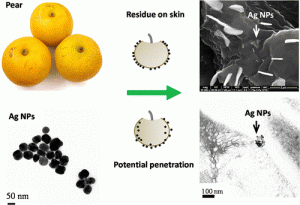 The last decade has witnessed a large influx in the use of nanotechnology in consumer products, including food, clothing, cosmetics, fertilizers, and pesticides. The growth of this technology has elicited strong reactions from scientists across the globe, with many asserting that further research is urgently needed to evaluate the potential impacts of these novel substances. As Mengshi Lin, Ph.D, associate professor at the University of Missouri (MU) and co-author of the study states, âMore than 1,000 products on the market are nanotechnology-based products. This is a concern because we do not know the toxicity of the nanoparticles. Our goal is to detect, identify and quantify these nanoparticles in food and food products and study their toxicity as soon as possible.â
The last decade has witnessed a large influx in the use of nanotechnology in consumer products, including food, clothing, cosmetics, fertilizers, and pesticides. The growth of this technology has elicited strong reactions from scientists across the globe, with many asserting that further research is urgently needed to evaluate the potential impacts of these novel substances. As Mengshi Lin, Ph.D, associate professor at the University of Missouri (MU) and co-author of the study states, âMore than 1,000 products on the market are nanotechnology-based products. This is a concern because we do not know the toxicity of the nanoparticles. Our goal is to detect, identify and quantify these nanoparticles in food and food products and study their toxicity as soon as possible.â
MU scientists began their testing by immersing several pears in a solution containing nanosilver at 20 nanometers (nm) and 70 nm, effectively mimicking a pesticide application. The team then repeatedly washed and rinsed the pears and observed the presence of nanoparticles on the pearâs skin and pulp. Results showed that both the 20 and 70nm nanosilver particles remained on the pears skin after 4 days, while the 20nm particles were in fact also able to penetrate the pearâs skin and reach the inside of the pearâs pulp. âThe penetration of silver nanoparticles is dangerous to consumers because they have the ability to relocate in the human body after digestion,â Dr. Lin said. âTherefore, smaller nanoparticles may be more harmful to consumers than larger counterparts.â
The scientists note that, once ingested, nanoparticles can pass into the blood and lymph system, circulate through the body and reach potentially sensitive sites such as the spleen, brain, liver, and heart. Nanosilverâs presence in clothing and cosmetics provides another potential route of exposure. A recent study revealed that athletic wear impregnated with nanosilver can cause the substance to seep into a personâs skin through oneâs sweat. A 2009 study showed that washing these types of nanosilver-impregnated textiles resulted in an unknown spread of the substance into the environment. Due to its small size, nanosilver is often not filtered out by conventional wastewater treatment plants. After entering the environment, past studies show nanosilver can have devastating impacts on wildlife, including deformities in fish and immune suppression in earthworms.
The U.S. Environmental Protection Agency (EPA) has been criticized by scientists and consumer and environmental groups for its role in regulating emerging nanotechnology. A 2013 National Resources Defense Council (NRDC) report provided a scathing account of EPAâs âconditionalâ registration of nanosilver, which the agency approved under the assumption that its use would reduce the overall burden of conventional silver in the environment. However, despite its novel antibacterial properties, the material did not undergo a full range of required tests, and there is no labeling system that would alert consumers to the presence of this largely untested substance in consumer products. A 2012 industry newsletter placed EPAâs delay over nanotechnology regulation on White House officials in the Office of Management and Budget (OMB). Richard Denison, PhD, senior scientist at the Environmental Defense Fund explained, âMy understanding is that there is a view in some circles in the White House that they do not want to stigmatize nanomaterials nor stifle the technology even by requiring the reporting of information that EPA needs to make judgments as to whether there are risks.â
The only surefire way to avoid nanomaterials in food is to buy USDA organic certified products. The National Organic Standards Board (NOSB) imposed a general ban over nanotechnology in its fall 2010 meeting, although USDAâs National Organic Program has never initiated rulemaking on the subject. The growth and success of organic agriculture shows that risky nanosilver pesticides are not necessary to feed the world. Â Organic practices that build soil and microbial diversity create natural pest resilience, and produce yields comparable to conventional agriculture. To find out more about the benefits certified organic products and production systems, visit Beyond Pesticidesâ organic food program page.
Additional information on the regulatory history and risks associated with nanotechnology can be found on Beyond Pesticidesâ nanosilver webpage.
Source: MU News Bureau
Image Source: Journal of Agriculture and Food Chemistry
All unattributed positions and opinions in this piece are those of Beyond Pesticides.
Posted in Antibacterial, Nanotechnology, Water by: Beyond Pesticides
No Comments
26
Aug
(Beyond Pesticides, August 26, 2013) A recent study presented by the Centers for Disease Control and Prevention (CDC) Â at the International Conference on Lyme Borreliosis and other Tick-Borne Diseases in Boston finds that spraying lawns with the insecticide bifenthrin does not reduce the incidence of tick-borne diseases. The study could have important policy implications for towns and communities that are feeling pressure to spray as prevalence of tick-borne diseases, such as Lyme disease, continue to rise. Â There are least-toxic alternative management strategies that are effective and 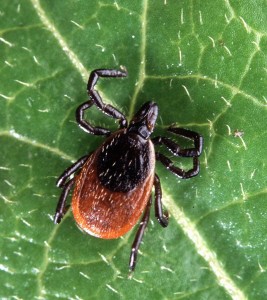 safer than chemical controls.
safer than chemical controls.
The recently released study by CDC included 2,500 households in Fairfield, Litchfield, and New Haven Counties in Connecticut; Dutchess County in New York; and four counties in Maryland. Half of the householdsâ lawns were sprayed with bifenthrin and the other half was sprayed with water as a control. The study, conducted over two years, found that the households that were sprayed with bifentrhin saw a 60 percent reduction in ticks on their propriety but still had similar levels of tick encounters and tick-borne illnesses. These final results are similar to the results the study found after its first year. Â This research reveals that using pesticides is not an effective way to curb tick-borne disease and can leave families dealing with another medical issue: the negative health effects that can be brought on by the use toxic pesticides.
This study’s findings are also important because as tick-borne illness are increasing there will be greater pressure for communities to use toxic controls for ticks. Â A few days before CDC released its study on pesticides the CDC reported preliminary estimates indicating the number of Americans diagnosed with Lyme disease each year is around 300,000. The new estimate suggests that the total number of people diagnosed with Lyme disease is roughly 10 times higher than the yearly reported number to CDC. Lyme disease cases, which are caused by the bacterium Borrelia burgdorferi being transmitted to humans through the bite of infected ticks, Â are concentrated heavily in the Northeast and upper Midwest, with 96 percent of cases in 13 states. Paul Mead, M.D., M.P.H, chief of epidemiology and surveillance for CDCâs Lyme disease program, cautioned in a CDC press release, âThis new preliminary estimate confirms that Lyme disease is a tremendous public health problem in the United States, and clearly highlights the urgent need for prevention.â
Beyond Pesticides was critical of CDC and the Maryland Department of Health and Mental Hygieneâs decision to enroll Maryland households into the recently released pesticide study in 2012 after its first year because of the lack of (i) public disclosure of the test pesticides’ potential health effects and (ii) attention to the efficacy of alternative management strategies. Beyond Pesticides  maintains that it was wrong to put test families at risk of pesticide exposure, especially since the study found pesticides are ineffective in curbing tick-borne illnesses in its first year. Beyond Pesticides also found the information about the study posted on the CDCâs website misleading, as it did not fully inform participants of the hazards posed by bifenthrin. Beyond Pesticides spoke directly with state health officials in an effort to relate concerns about this study. âItâs improper to be conducting a human experiment like this,â said Jay Feldman, executive director of Beyond Pesticides.
Bifenthrin, the insecticide used in the recent CDC pesticide study, is identified as an endocrine disruptor by the European Union (May 2010), and is considered a possible carcinogen by the U.S Environmental Protection Agency (EPA). It is a pyrethroid class pesticide, a group of known neurotoxic chemicals. A recent study in the journal Environmental Health Perspectives (2007) of infants born to women with agricultural exposure shows a possible impact of bifenthrin on the occurrence of autism spectrum disorders. Bifenthrin is also toxic to birds, fish and bees.
Though toxic methods have been proven unsuccessful in stopping tick-borne illnesses, there are safe, non-toxic alternatives that are successful. In areas that are potential tick habitats, you should wear light-colored clothing that covers the body (especially your legs) because it makes it easier to spot ticks so they can be removed before they bite.
Another effective way to avoid ticks is to only use unscented deodorant, soap and shampoo. An exception is Packers Tar Soap, which has a natural pine scent which can keep ticks from biting once they have been picked up. Similarly, you can try using least-toxic herbal repellants such as oil of lemon eucalyptus and essential oils. Most importantly, after you have walked through high grass in a tick infested area, check the entire body for ticks and shower to wash off any ticks that have not yet become embedded.
If you do find an embedded tick, remove it carefully. Protect your hands with gloves or a tissue. Use blunt, curved tweezers, not your bare fingers, and exert pressure on the head of the tick and gently pulling the tick straight out very slowly. Do not twist and do not crush the tick. The body fluids can cause infection if exposed to even unbroken skin. Do not kill the tick while still embedded. Kill the tick in soapy water or alcohol, clean the wound with antiseptic, and monitor carefully for any signs of infection. If you observe symptoms of Lyme disease such as a bullâs-eye rash near the bite, consult a physician.
For more information on alternative pest management, please visit Beyond Pesticidesâ alternative factsheets page.
All unattributed positions and opinions in this piece are those of Beyond Pesticides. Â
Source: Poughkeepsie Journal
Posted in Bifenthrin, Lawns/Landscapes, Ticks by: Beyond Pesticides
No Comments
23
Aug
(Beyond Pesticides, August 23, 2013) Beyond Pesticides, along with upwards of 150 U.S. farm and food businesses and organizations, sent a letter to the U.S. Department of Agriculture (USDA) calling on the department to strengthen their oversight of field trials of experimental, genetically engineered (GE) crops. The letter comes in response to the USDAâs announcement in May 2013, that unapproved GE wheat developed by Monsanto was discovered in a farmerâs field in eastern Oregon. GE material drifts  and contaminates non-GE  and organic fields, economically crippling these farmers.
The letter, which was addressed to USDA Secretary Tom Vilsack, is supported by food and farming organizations calling for tighter regulations and oversight of GE crops, particularly for experimental field trials. âCurrent U.S. policy includes neither mandatory contamination prevention measures nor an adequate system for monitoring the success of containment following trials,â charged the Organic Seed Alliance and the Rural Advancement Foundation International in a recent press release.
Many of these farmers and members of these groups require this oversight to protect their very livelihoods. âAnnually, we use over 10 million pounds of organic wheat,â said Steve Crider, government and industry liaison for Amyâs Kitchen. âTherefore, the integrity of non-GMO wheat is essential to our continued success as a business. âËGMO-freeâ is what our customers demand and expect, both domestically here in the U.S. and our extensive export program abroad into Asia, the E.U., and the Middle East markets we serve.â
The letter was sent to USDA in late July and as a follow up groups met with Secretary Tom Vilsack last week in Washington D.C. to discuss the concerns laid out in the letter. The groups asked that USDA âfix its rubber-stamp approach to GE cropsâ and continued that âimprovements in regulations and oversight must start at the field trial stage.â
Courtney Rowe, USDA spokeswoman told Reuters that the meeting between Mr. Vilsack and the groups was productive. âWe are currently carefully reviewing the concerns and information shared with us and will be responding in full in the near future,â Ms. Rowe said.
Groups await USDAâs response to their requests which include the following:
- Â âUSDA should halt new approvals of GE wheat field trials at least until the Oregon contamination investigation is complete.
- USDA should fully implement recommendations made by investigative bodies and Congress that aim to improve field trial oversight.
- USDA should publish a final report detailing the departmentâs investigation into the Oregon wheat event, including sampling and testing methodologies.
- Before approving field trials, USDA should have the appropriate tools in hand to test for unapproved GE traits in cases of suspected and confirmed contamination events.
- USDA should require mandated containment protocols for all GE crop field trials.â
USDA says, in a conversation with Reuters, that it has in fact strengthened its oversight of biotech crop field trials in recent years. Since 2007, USDA  has  increased the number of inspections by about 200 inspections per year, from 500 inspections in 2007 up to 700 this last year. Additionally, the department has improved training for monitoring compliance with test protocols.
However, GE contamination of non-GE crops is not isolated to the wheat fields in eastern Oregon. Biotech rice developed by Bayer to resist herbicides, was found in food supplies in 2006, despite being unapproved for human consumption. The event crippled more than 7,000 long-grain rice producers, as Japan and the European Union (EU) restricted the importation of U.S. rice, causing rice prices to plunge. Bayer CropScience announced in 2011 that it would pay up to $750 million to settle claims. Similarly, corn contaminated with unapproved GE traits was found in U.S. corn crops in 2005 and 2006. Clearly, the problems with regulatory oversight of GE crops are not restricted to the recent event in Oregon; the letter to USDA Secretary Vilsack highlights the issues.
In addition to the economic harm, the growth of GE crops also has severe negative impacts on the environment. A recent study by researcher Charles Benbrook, Ph.D. shows that GE crops have significantly increased pesticide use and weed resistance, contrary to industry claims that the technology would reduce herbicide applications. As weed resistance increases, growers have started to look towards other chemically intense methods to fight weeds. The explosion of GE crops has also been linked to a decline in pollinator populations.
For more information on the environmental hazards associated with GE technology, visit Beyond Pesticidesâ Genetic Engineering webpage. The best way to avoid genetically engineered foods in the marketplace is to purchase foods that have the U.S. Department of Agriculture (USDA) Certified Organic Seal. Under organic certification standards, genetically modified organisms and their byproducts are prohibited. For many other reasons, organic products are the right choice for consumers.
Source: Reuters, RAFI
All unattributed positions and opinions in this piece are those of Beyond Pesticides.
Posted in Agriculture, Alternatives/Organics, Contamination, Genetic Engineering by: Beyond Pesticides
1 Comment
22
Aug
(Beyond Pesticides, August 22, 2013) After four years of relying on non-toxic mechanical controls to clear weeds on rights-of-way across Cape Cod, the Massachusetts-based power company NStar announced that it will begin using herbicides again this fall. All 15 Cape Cod towns have signed a no-spray resolution in 2011 and 2013, requesting NStar to use non-chemical means to defoliate transmission line easements, citing concerns for pesticide drift into the ground and surface water. Yet, despite extensive local opposition to the spraying, and evidence of the efficacy of organic land management to control weeds, NStar has refused to seriously consider alternative methods to spraying toxic herbicides.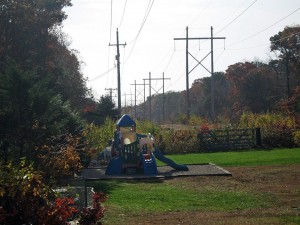
Many of the targeted spray areas where power lines are located are in close proximity to homes with private wells, in areas that drain into public water supplies, and adjacent to bike and walking paths. The pesticides can persist in the soil and be tracked into homes, or enter the surface or ground water where drinking water is sourced. Nearby residents can be exposed to drift, which can cause numerous adverse health effects.
Following the announcement, there is a 45-day comment period (which commenced August 7) overseen by the Massachusetts Department of Agricultural Resources (MDAR), which will have to grant approval before spraying can begin. Communities scheduled to be a part of the program include: Barnstable, Bourne, Brewster, Chatham, Falmouth, Harwich, Orleans and Sandwich. Many of these areas have taken steps toward organic land management on public property, and have previously fought against right-of-way applications by NStar.
Before 2004, NStar used effective non-chemical methods for controlling weeds along its rights-of-way, including mechanical cutting and hand-mowing. Between 2004 and 2007, NStar quietly began spraying herbicides. In 2008, when NStar filed a new Vegetation Management Plan, residents became aware of this practice, which prompted concerns. Â Several organizations and businesses formed a coalition, Cape Cod for a Truly Green NStar, in an effort to convince NStar to stop using herbicides on rights-of-way, in support of a ban on herbicides along rights-of-way. After months of public outcry, NStar agreed to a one-year moratorium on spraying until the end of 2010; increased pressure from local activists and residents resulted in NSTAR agreeing with the regional planning authority, Cape Cod Commission, to postpone the use of herbicides on rights-of-way until 2011.
âWe suspended our use of herbicides on Cape Cod so we could listen and respond to local concerns about the program, and work cooperatively to address those concerns,â said Steve Sullivan, Vice President of Operations Services for Northeast Utilities, NSTARâs parent company. âIn the meantime, weâve had to exclusively rely on less effective mechanical methods in order to protect electric service reliability on the Cape. An Integrated Vegetation Management program is a much more sustainable practice, as it does not rely on the repeated mowing down of everything growing within a right-of-way.â
However, when used in an effective manner, mechanical practices, which include cutting, girdling, mowing and grazing animals, provide effective means to eradicate unwanted vegetation along rightsâÂofâÂway. Bad mowing practices, on the other hand, can actually cause many problems. Mowing too low, for instance, can kill the root system by preventing photosynthesis, and invites sunlight in for weeds to sprout.
Sue Phelan, director of GreenCAPE, a grassroots organization in Cape Cod that works to eliminate hazardous pesticides from the region, told the Cape Cod Online that NStar did not thoroughly consider alternatives to the use of herbicides. There are a number of different types of habitats in the Cape, and it is not a âone size fits all,â she said.
The company has previously refused to use goats, despite local attempts to utilize them. NStar has said that its customers do not want the clear cutting that mowing mimics and would not consider it, even with an electrical fence to keep them out of unwanted areas. However, grazing goats is a great option for land that suffers from unwanted plants, low organic matter and soil compaction, and they can be penned out of areas where the vegetation should remain intact. In fact, many places across the country, including the Congressional Cemetery in Washington, DC, have found success with using goats to for weed control.
Each year, millions of miles of roads, utility lines, railroad corridors and other types of rights-of-way are treated with herbicides to control the growth of unwanted plants. Unfortunately, drift from the application of these herbicides can negatively affect waterways, residents and organic farmers. Rights-of-way include roads, utility lines, and railroad corridors, although different states have varying policies for maintaining rights-of-way.
The best management strategy for weeds is to prevent them in the first place or manage ecosystems that are healthier and less susceptible to invasion. Beyond creating stronger ecosystems and working to prevent invasion, there are successful least-toxic weed management practices that can be used if an invasive species has been introduced into an area.
Biological methods, such as the use of native vegetation, in conjunction with mechanical means, create and encourage stable, lowâÂmaintenance vegetation that is a more permanent vegetation management strategy. The establishment of desirable plant species that can outâÂcompete undesirable species requires little maintenance and meets the requirements for management. Although native vegetation may take more time to establish itself, native flower and grass species are better adapted to local climate and stress. Native plant species are especially effective in providing increased erosion control, aesthetics, wildlife habitat, and biodiversity.
The combination of using these mechanical, biological and nontoxic vegetation control methods, along with planting native plant species effectively, reduces and eliminates the need for pesticide applications. Ultimately, creating and encouraging stable, low-maintenance vegetation is a more permanent vegetation management strategy than the constant application of toxic pesticides.
To learn more about how states can and have handled rights-of-way management, read Beyond Pesticides article âThe Right Way To Vegetation Management.â
Take Action (Massachusetts):
- Call or write the Director of Rights-of-Way Program/Pesticide Bureau Mike McLean [email protected], and MDAR Commissioner [email protected] or Phone: 617-626-1701. Tell them you object to the application of herbicides on NStar rights-of-ways, particularly given that safer alternative exist. Be sure to get a tracking receipt for your e-mails. GreenCAPE recommends CCing your state Representative and Senator as well (see www.mass.gov for information). Additionally, GreenCAPE is asking folks to send pictures of the right-of-way in your back yard or neighborhood, particularly where children live and play.
- Call NStar and tell its representative that you object to the use of herbicides along the Cape’s rights-of-way and that you would like to see a more long-term, sustainable approach to vegetative management. Ask NStar to maintain the power line easements the way they have for many years-selective cutting and mowing. Â NStar President and CEO Tom May at (617) 424-2527 and Investor Relations at (781) 441-8338 or (https://www.nu.com/forms/formInvestors.asp).
- Call your local officials (town administrators, select boards and town councils) and urge them to remind NStar (in a letter and verbally) that the town has already adopted a resolution opposing the NStar spraying.
For more information, see GreenCAPEâs factsheet. For more information on what you can do and whatâs happening on Cape Cod, see GreenCAPEâs facebook page.
Take Action (Nationally): Â Some states allow residents the right to refuse herbicide use on their property and people can post their property with no spraying signs provided by the utilities. For example, Maine, North Carolina, and Oregon all have no-spray agreements. If you are interested in becoming active in your community to stop spraying on rights-of-way or other public spaces, such as parks and schools, please refer to our Tools for Change webpage and read The Right Way To Vegetation Management, which contains information about spraying policies along rights-of-way in different states.
All unattributed positions and opinions in this piece are those of Beyond Pesticides.
Photo courtesy: Sue Phelan, GreenCAPE.
Posted in Massachusetts, Pesticide Drift, Take Action, Water by: Beyond Pesticides
2 Comments
21
Aug
(Beyond Pesticides, August 21, 2013) Suffolk County, New York, Legislator Jay Schneiderman (I-Montauk) introduced a bill on July 30, 2013 to establish strict guidelines for the use of methoprene within estuaries in Suffolk County. Â Methoprene, an insect growth regulator, is commonly used in mosquito control programs, but is highly toxic to estuarine invertebrates, including crabs and lobsters, which are the backbone of the fishing industry along the East coast. This bill  follows similar legislation already passed in Connecticut and Rhode Island to help protect lobster populations.
follows similar legislation already passed in Connecticut and Rhode Island to help protect lobster populations.
The lobster population in the Long Island Sound has decreased dramatically over the last decade, corresponding with the introduction of pesticides such as methoprene in mosquito control programs. Methoprene  is an insect growth regulator that prevents development to the adult reproductive stages so that insects die in arrested immaturity. It is an insecticide that is acutely toxic to estuarine invertebrates, including valuable food and commercial species like crabs and lobsters.  The effect of mosquito pesticides on marine life, especially lobsters, has come under scrutiny in recent years as mosquito spray programs in various states escalated efforts to suppress West Nile virus (WNv). Other mosquito-killing chemicals suspected of causing damage to aquatic life include many pyrethroid and organophosphate insecticides, which are known to be toxic to many aquatic species, including crustaceans.
Mr. Schneiderman’s  bill (IR 1692-13) stipulates that methoprene could only be applied in estuaries when one or more disease threats have been identified in local mosquito populations, or two or more bacterial insecticide treatments, such as Bacillus Thuringiensis Israelensis (BTI), have been unsuccessful in limiting mosquito population numbers.
âThe county should be doing everything it can to limit the unnecessary introduction of toxins into our environment. Methoprene poses the possibility of causing damage to key species that our recreational and commercial fishermen depend on. There are alternatives to methoprene that have not been shown to be harmful to our crabs and lobsters,â said Mr. Schneiderman.
Declines in the Long Island Soundâs lobster population have been alarmingly common for the past 15 years, devastating fishermen and the local economy that depends on them. Lobster populations fell from 3.7 million pounds in 1998 to 142,000 pounds in recent years, and pesticides have long been suspected in killing off lobsters. In 2003, researchers at the University of Connecticut found that methoprene was deadly to lobsters at concentrations of only 33 parts per billion, and in 2012 Â a Connecticut state Department of Energy and Environmental Protection study detected residues of mosquito control pesticides: malathion, methoprene, and resmethrin in lobsters pulled from Long Island Sound. Lobstermen have long challenged the use of methoprene and other mosquito control pesticides, and have been vocal about the need for alternative methods for WNv control, including switching to the use of the less toxic Bacillus Thuringiensis (Bt).
Connecticut recently passed legislation banning methoprene. This bill was in direct response to decreased lobster population in the Long Island Sound. The Connecticut law prohibits the introduction of methoprene into any storm drain or conveyance of water in the coastal boundary zone in an effort to prevent these chemicals from being introduced into the Long Island Sound. Similarly, cities and towns throughout Rhode Island have also stopped using methoprene in storm drains and instead use Bacillus Sphaericus – a naturally occurring bacterium related to Bt that kills mosquitoes without affecting lobsters or other non-target organisms. Maine is the only East Coast fishery where methoprene has been banned for an extended period. As a result, the lobster population is at acceptable, sustainable levels.
Mr. Schneiderman first introduced similar controversial restrictions in 2007, but they were not adopted by the legislature after opposition from Suffolk County Vector Control officials, even though New York City banned the use of methoprene in 2001 in areas where it would spread into wetlands and groundwater. Mr. Schneiderman hopes his bill will fare better this time in light of the new studies and legislative action in Connecticut, Rhode Island and other areas. The new legislation in Connecticut and Rhode Island are being met with resistance from some who believe that these policies will lead to an  increased risk of West Nile Virus (WNv) and Eastern Equine Encephalitis (EEE). However, these new laws explicitly allow the use of the chemicals if a mosquito-borne disease is found or suspected.
Mosquito spraying programs have been legally challenged in Suffolk County. A 2004 lawsuit was filed by Peconic Baykeeper, part of the Riverkeeper environmental action network, against Suffolk countyâs mosquito spray program to reform mosquito control practices in the county. The suit charged that Suffolk County violated the Clean Water Act (CWA) by filling wetlands with dredge spoil, discharging pollutants conveyed through mosquito ditches, and discharging restricted pesticides into surface waters. For four years prior to the legal action under New York State environmental law, Peconic Baykeeper’s advocacy  helped persuade Suffolk County to adopt methods of mosquito control that are health-based, scientifically-justified, and not destructive to the environment.
There are safer and effective options for dealing with mosquitoes and insect-borne diseases. The ideal mosquito management strategy comes from an integrated approach emphasizing education, aggressive removal of standing water sources, larval control, monitoring, and surveillance for both mosquito-borne illness and pesticide-related illness. Beyond Pesticides advises communities to adopt a preventive, health-based mosquito management plan, and has several resource publications on the issue, including the Public Health Mosquito Management Strategy: For Decision Makers and Communities. Visit Beyond Pesticidesâ West Nile Virus/Mosquito Management for more details.
All unattributed positions and opinions in this piece are those of Beyond Pesticides.
Source: News Release: Office of Jay H. Schneiderman, Suffolk County Legislator, Second District
Posted in Agriculture, Integrated and Organic Pest Management, Methoprene, Mosquitoes, New York, State/Local, Water, Wildlife/Endangered Sp. by: Beyond Pesticides
No Comments
20
Aug
(Beyond Pesticides, August 20, 2013) In a victory for consumers and Willamette Valleyâs $50 million vegetable seed industry, Oregon Governor John Kitzhaber signed HB 2427 last week, banning the commercial production of canola in the region until at least 2019. Supporters of the law assert that the moratorium is necessary to maintain the integrity of the regionâs internationally recognized organic vegetable seed industry.
Farmers in Oregonâs specialty seed and organic vegetable industries, valued at well over $50 million in annual sales, have been fighting the planting of  canola, an oilseed plant in the brassica family, in the Willamette Valley because it readily cross-pollinates with specialty crops grown there, the brassica specialty seed crops like broccoli, kale, and cabbage. Canola can  spread plant diseases and pests to brassica vegetable and seed crops; and can contaminate pure lots of vegetable and clover seed, rendering them unsalable in international and local markets. Additionally, genetically engineered (GE)  herbicide resistant varieties of canola can further cross-pollinate with weeds, creating new invasive species problems as herbicide resistant traits spread to native weed populations.
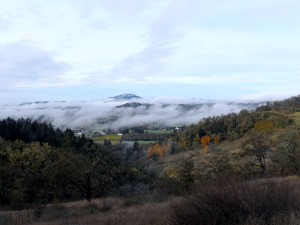 The canola controversy emerged after  a decision by the Oregon Department of Agriculture (ODA) last year to temporarily allow the planting of GE canola in areas  of the Willamette Valley previously deemed off-limits. The new rules were not subject to a public comment period. At the time, ODA Director Katy Coba stated that, âSince canola has been deregulated by USDA, ODA does not differentiate between conventional and [GE] canola or treat them differently.â The new rules spurred a lawsuit, filed by the groups Center for Food Safety and Oregon-based Friends of Family Farmers, in conjunction with Oregon specialty seed producers Universal Seed, Wild West Seeds, and Wild Garden Seeds. Shortly after the announcement, the Oregon Court of Appeals granted the plaintiffs a temporary halt to canola planting. In response, ODA agreed to hold two public comment periods, one in November 2012 and another in January 2013. Widespread public opposition did not compel ODA to withdraw the proposal, however, and in February 2013 the department officially approved a spring 2013 planting of the  canola in the Willamette Valley Protected District.
The canola controversy emerged after  a decision by the Oregon Department of Agriculture (ODA) last year to temporarily allow the planting of GE canola in areas  of the Willamette Valley previously deemed off-limits. The new rules were not subject to a public comment period. At the time, ODA Director Katy Coba stated that, âSince canola has been deregulated by USDA, ODA does not differentiate between conventional and [GE] canola or treat them differently.â The new rules spurred a lawsuit, filed by the groups Center for Food Safety and Oregon-based Friends of Family Farmers, in conjunction with Oregon specialty seed producers Universal Seed, Wild West Seeds, and Wild Garden Seeds. Shortly after the announcement, the Oregon Court of Appeals granted the plaintiffs a temporary halt to canola planting. In response, ODA agreed to hold two public comment periods, one in November 2012 and another in January 2013. Widespread public opposition did not compel ODA to withdraw the proposal, however, and in February 2013 the department officially approved a spring 2013 planting of the  canola in the Willamette Valley Protected District.
Heeding the publicâs outcry, Oregonâs legislature acted swiftly to advance HB 2427, which now in effect overturns ODAâs previous rulings. George Kimbrell, senior attorney for Center for Food Safety, explains, âWorking closely with the farmers and allies, we were able to act fast to prevent ODAâs disastrous decision from taking effect. Our court case prevented any canola from being planted, allowing time for our legislative strategy to work. Fortunately, this new law will trump the agencyâs unlawful rule that would have allowed planting. This valuable industry is safe from the threat of canola.â Apart from the moratorium, the law also requires Oregon State University to conduct a study to determine whether the canola is compatible with other crop production within the protected planting district of the Willamette Valley. This will ensure that any decisions made will follow the principles of rigorous, peer-reviewed science, notes Ivan Maluski, policy director at Friends of Family Farmers.
A previous Oregon State University report, âOutcrossing Potential for Brassica Species and Implications for Vegetable Crucifer Seed Crops of Growing Oilseed Brassicas in the Willamette Valley,â confirms that canola has the ability to hybridize with brassica seed crops such as radish, cabbage, broccoli, cauliflower, brussels sprouts, kohlrabi, collards, and kale.
Organic growers are particularly concerned about canola planting because certification does not allow the introduction of GE material in organic seeds or vegetables. Such contamination has proven to be  extremely costly to farmers raising organic and non-genetically engineered crops whose loads are rejected by buyers when trace levels of contamination are detected. Farmers in these circumstances lose a price premium for the extra effort and expense taken to preserve their cropâs integrity and they typically have no recourse but to dump the load on generic markets. The signing of HB 2427 comes only a few months after an Oregon wheat farmer discovered the presence of unregulated GE wheat in his field, which prompted international markets in Europe, Japan, and South Korea to reject U.S. wheat imports.
Under the current interpretation of relevant law, genetic seed producers bear no legal or financial responsibility for such contamination. In an effort to get the U.S. Department of Agriculture (USDA) to act on this issue, in its spring 2012 meeting, the National Organic Standards Board, with a unanimous vote, sent a letter to Secretary of Agriculture Tom Vilsack saying, âWe see the potential of contamination by genetically engineered crops as a critical issue for organic agricultural producers and the consumers of their products. There are significant costs to organic producers and handlers associated with preventing this contamination and market loss arising from it.â
The fall National Organic Standards Board (NOSB) meeting, scheduled for October 22-24th in Louisville, KY, is fast approaching. Stay tuned to Beyond Pesticidesâ Keeping Organic Strong webpage for an overview of the issues to be discussed, which will include the issue of GE contamination of organic crops. Previous board meetings and topics can be viewed on Beyond Pesticidesâ NOSB Archives page. For additional information, see our issue pages on Organic Agriculture and Genetic Engineering.
All unattributed positions and opinions in this piece are those of Beyond Pesticides.
Source(s): Center for Food Safety, Processing Magazine
Posted in Agriculture, Alternatives/Organics, Contamination, Genetic Engineering, Litigation, National Organic Standards Board/National Organic Program, Oregon by: Beyond Pesticides
1 Comment
19
Aug
(Beyond Pesticides, August 19, 2013) The U.S. Environmental Protection Agency’s (EPA) new pesticide label for honey bee protection, announced Thursday, has been widely criticized by beekeepers and environmentalists as offering inadequate protection in the face of devastating bee decline. Under the new guidelines, the label will prohibit the use of some neonicotinoid pesticides when bees are present, and includes a âbee advisory boxâ and icon with information on routes of exposure and spray drift precautions. Critics question the efficacy of the label change in curtailing a systemic pesticide that contaminates nectar and pollen, poisoning bees indiscriminately, and the enforceability of the label language, which is geared to managed not wild bees. EPA has not formally acknowledged the peer-reviewed science linking neonicotinoid pesticides to colony collapse disorder and bee decline, as is the case with the European Union’s European Food Safety Authority (EFSA), where neonicotinoids are being phased out.
Specifically, the new label applies to pesticide products containing the neonicotinoids imidacloprid, dinotefuran, clothianidin and thiamethoxam. Neonicotinoids are a relatively new class of insecticides that share a common mode of action that affect the central nervous system of insects, resulting in paralysis and death. They include imidacloprid, acetamiprid, clothianidin, dinotefuran, nithiazine, thiacloprid and thiamethoxam. Peer-reviewed science has repeatedly identified these insecticides as highly toxic to honey bees and other pollinators. The neonicotinoid class of insecticides has been identified as a leading factor in bee decline.
âMultiple factors play a role in bee colony declines, including pesticides. The Environmental Protection Agency is taking action to protect bees from pesticide exposure and these label changes will further our efforts,â said Jim Jones, assistant administrator for EPA’s Office of Chemical Safety and Pollution Prevention.
Unfortunately, this label change does not address the fact that neonicotinoids are systemic, meaning plants take up these pesticides and exude them in their pollen and nectar, with residues remaining in the plant for its lifetime, continually endangering any pollinators that forage or pollinate  these contaminated plants.  Additionally, the bulk of neonicotinoid uses are in fact for treated seed, which accounts for the majority of corn planted in the U.S.  Contaminated dust that originates from the planting of these seeds drift off fields and have been known to kill large numbers of bees. Recently, 37 million honeybees were reported dead across a single farm in Ontario from the dust associated with planting neonicotinoid-treated corn seeds.  According to New York beekeeper Jim Doan, âIn New York state, for example, foliar application of neonics are used only for apples and some vegetables, and not used for the majority of the crops out there â corn and soybeans â which are seed coatings. When I heard about the new labeling requirements, my first question was, so are we going to put these labels on the bags of corn? No.â
Neonicotinoids are primarily used as seed treatment for corn and soybeans, as well as in home and garden products. These chemicals contaminate nectar and pollen, as well as soil and surface water.  Foraging and navigational disruptions, immune suppression and learning/memory disorders have been documented in bees exposed to even low levels of these chemicals. An extensive overview of the major studies showing the effects of neonicotinoids on pollinator health can be found on Beyond Pesticidesâ What the Science Shows  webpage.
There is also concern that the new label language is unenforceable. EPA is aware that label directions such as these are not adhered to in the real-world. Many beekeepers can attest to this and have repeatedly communicated this to EPA enforcement and registration officials. Addressing lack of compliance has been an area the agency has not sufficiently addressed throughout the years. For instance, after specifying that, âthe product may not be applied while bees are foraging. Do not apply this product until flowering is complete and all petals have fallen,â EPA adopts the loophole:
âIf an application must be made when managed bees are at the treatment site, the beekeeper providing the pollination services must be notified no less than 48-hours prior to the time of the planned application so that the bees can be removed, covered or otherwise protected prior to spraying.â
This keeps the onus on the beekeepers to make sure their bees are safe.
On March 21, 3013, Beyond Pesticides joined beekeepers, environmental and consumer groups in filing a lawsuit in Federal District Court against EPA for its failure to protect pollinators from dangerous pesticides. The coalition is seeking suspension of the registrations of insecticides- clothianidin and thiamethoxam- which have repeatedly been identified as highly toxic to honey bees, clear causes of major bee kills and significant contributors to the devastating ongoing mortality of bees known as colony collapse disorder (CCD). Â The suit challenges EPAâs oversight of these bee-killing pesticides, as well as the agencyâs practice of âconditional registrationâ and labeling deficiencies.
In the meantime, EPA has stated it would support short-term mitigation measures, such as improved seed coatings to reduce contaminated dust, and improved farming equipment, measures which do not go far enough to protect both commercial and wild bee populations. These new label changes, while an improvement from current pollinator hazard statement on pesticide labels, also do not go far enough to protect bees, especially wild bees.
âThis is a step forward, certainly, but it does not address the issue that we need to address. EPA deserves a pat on the back for coming up with something, but we have a long ways to go,â said Mr. Doan. âWe need to continue to put pressure on the agency and the industry and keep moving forward.â
Earlier this year, the EU announced a two-year suspension on these bee-killing pesticides. In early July, Beyond Pesticides urged President Obama in a joint letter to direct EPA to follow Europeâs lead in suspending certain neonicotinoid pesticides uses and take on even more protective measures, including a minimum two-year suspension for all outdoor uses of neonicotinoid insecticides pending resolution of their hazards to bees and beneficial organisms. Highlighting the negative environmental and economic impacts of outdoor uses of the EPA-approved neonicotinoid insecticides as well as a recognition that the initial risk assessments for these chemicals fail to adequately consider key risks to bee health, the letter to President Obama notes that it, âwould not be responsible to continue to allow these threatening compounds to be used so broadly.â
With one in three bites of food reliant on bees and other beneficial species for pollination, the decline of these important species demands swift action. The mounting scientific evidence, along with unprecedented annual colony losses at 40 to 90 percent this year, demonstrates the impacts that these pesticides are having on these fragile beings.
Take Action: Beyond Pesticidesâ BEE Protective campaign has all the educational tools you need to stand up for pollinators. Some specific ways you can help are:
For information on what you can do to keep the momentum going, see www.BEEprotective.org.
Source: EPA Press Release
All unattributed positions and opinions in this piece are those of Beyond Pesticides.
Posted in Agriculture, Clothianidin, Imidacloprid, Pesticide Regulation, Pollinators, Take Action, Thiamethoxam by: Beyond Pesticides
No Comments
16
Aug
(Beyond Pesticides, August 16, 2013) Beyond Pesticides just helped release a new report with Friends of the Earth and other allies, revealing that the worldâs most popular pesticide, neonicotinoids, implicated as a key factor in global bee die-offs, may be lurking in our own gardens. As we celebrate National Honey Bee Day this weekend, join in asking Loweâs, Home Depot and other leading garden centers to take action and stop the sale of neonicotinoids and plants treated with these bee-killing chemicals.
Take Action: Bee Protective! Tell Home Depot, Loweâs and others to stop selling bee-killing products.
 There are now dozens of insecticides on retail shelves that contain neonicotinoids. Product labels show the active ingredients of these products, including: imidacloprid, Â acetamiprid, clothianidin, dinotefuran, nithiazine, thiacloprid and thiamethoxam. While neonicotinoids is a relatively new class of insecticide that affects the central nervous system of insects, a growing body of science has demonstrated neonicotinoids (neonics) are a key factor in bee decline nationwide, with beekeepers recording losses of up to 90 percent of their bees this winter. Recently, 50,000 bumblebees, likely representing over 300 colonies, were found dead or dying in a shopping mall parking lot in Wilsonville, Oregon. Authorities confirmed that this massive bee die-off was indeed caused by the use of a neonicotinoid pesticide, dinotefuran, on nearby trees. Â Similarly, 37 million honeybees were reported dead across a single farm in Ontario from the dust associated with planting neonicotinoid-treated corn seeds. Exposure to these chemicals also poses long-term risks to bees and can affect bee reproduction, foraging, navigation and memory, and also impairs their immune systems making them more susceptible to parasites and pathogens.
There are now dozens of insecticides on retail shelves that contain neonicotinoids. Product labels show the active ingredients of these products, including: imidacloprid, Â acetamiprid, clothianidin, dinotefuran, nithiazine, thiacloprid and thiamethoxam. While neonicotinoids is a relatively new class of insecticide that affects the central nervous system of insects, a growing body of science has demonstrated neonicotinoids (neonics) are a key factor in bee decline nationwide, with beekeepers recording losses of up to 90 percent of their bees this winter. Recently, 50,000 bumblebees, likely representing over 300 colonies, were found dead or dying in a shopping mall parking lot in Wilsonville, Oregon. Authorities confirmed that this massive bee die-off was indeed caused by the use of a neonicotinoid pesticide, dinotefuran, on nearby trees. Â Similarly, 37 million honeybees were reported dead across a single farm in Ontario from the dust associated with planting neonicotinoid-treated corn seeds. Exposure to these chemicals also poses long-term risks to bees and can affect bee reproduction, foraging, navigation and memory, and also impairs their immune systems making them more susceptible to parasites and pathogens.
A recent study by researchers at USDA finds that honey bees exposed to neonicotinoids are more susceptible to the deadly gut parasite, Nosema ceranae, contributing  further to declines in bee populations. Neonicotinoids have also been found to be toxic to grassland birds who eat neonicotinoid treated seed. A recent review by David Goulson, PhD, finds overall that broad ranging negative impacts occur from neoniconinoid use, not only on beneficial pollinators, but on overall biodiversity and ecosystem health.
The European Union (EU) is set to suspend the use of three neonicotinoid pesticides later this year, after a scientific review by European Food Safety Authority found that neonicotinoids pose an unacceptably high risk to bees. In the U.S. these chemicals are subject to a lawsuit in Federal District Court over the U.S. Environmental Protection Agency (EPA) failure to protect pollinators.
In addition to asking Lowe’s and Home Depot to stop the sale of of these products, we urge you to download and customize this sample letter and take it in to your local retailer customer service manager. Please tell us when you do (include store name, city and state), so we can follow-up!
Sample Letter:
Dear Sir/Madam:
I am writing to [insert company name] to commit to not sell neonicotinoid pesticides, as well as plants and seeds treated with these pesticides. A growing body of science shows that these pesticides are a key factor in global bee die-offs. Neonicotinoids, such as imidacloprid, clothianidin, thiamethoxam, dinotefuran, and acetamiprid, are highly toxic to bees and other beneficial organisms including birds and aquatic organisms. These chemicals contaminate the entire plant, including nectar and pollen, throughout the life of the plant, and also persist in soil and contaminate surface water. Recently, 50,000 bumble bees died in Oregon as a result of neonicotinoid application on trees. Beekeepers have lost as high as 90 percent of their hives this year alone. As a result of this, garden supply retailers should stop the sale of neonicotinoid pesticides to protect honey bees and other pollinators, essential for one in three bites of food in the U.S. and 20-30 billion dollars in our agricultural economy.
The European Union has already banned neonics and a majority of the UKâs largest home improvement retailers, including Homebase, B&Q and Wickes, have made public commitments to no longer sell products containing pesticides linked to declining bee populations. We call on to your company to join these leaders in sustainability and pollinator health by making this same commitment here in the U.S. to remove neonicotinoids from your shelves.
As a loyal customer, my family, friends, and I would appreciate your company taking a stand to protect honey bee health by discontinuing the sale of neonicotinoid-containing products at your store.
I look forward to hearing back from you and the opportunity to provide you with additional information. In the meantime, you can learn more about the effects of Neonicotinoids at www.BEEprotective.com.
Thank you for your urgent attention to this matter.
Sincerely,
____________________
Other Ways to BEE Protective for National Honey Bee Day
Through the BEE Protective campaign, Beyond Pesticides is leading a national public education effort supporting local action aimed at protecting honey bees and other pollinators from pesticides and contaminated efforts. Bees are in trouble and policy makers are just not acting quickly enough to help them, itâs your turn to join us in taking action to protect these beneficial insects.
- Tell your member of Congress to support the Save Americanâs Pollinators Act introduced last month by U.S. Representatives Earl Blumenauer (D, Ore.) and John Conyers (D, Mich.) to suspend the use of neonics on bee-attractive plants until EPA reviews all of the available data, including field studies. The bill, which Beyond Pesticides helped draft, aims to provide long overdue protections for America’s imperiled pollinators.
 Take the pollinator protection pledge to devote your own yard, garden, park, and backyard as a Pesticide-Free Zone that you can manage as organic pollinator habitat. We already have  6,529.74 acres pledged as organically managed and pollinator friendly, help us reach our goal of 10,000 acres this summer!
Take the pollinator protection pledge to devote your own yard, garden, park, and backyard as a Pesticide-Free Zone that you can manage as organic pollinator habitat. We already have  6,529.74 acres pledged as organically managed and pollinator friendly, help us reach our goal of 10,000 acres this summer!- Encourage your local schools, government agencies, religious institutions and businesses to use their buying power to go neonic-free. Urge your municipality, institution or company to adopt the model resolution which makes the commitment to protect pollinators from harmful pesticide applications and create pesticide-free refuges for these beneficial organisms.
- Plant your own colorful, bee-friendly garden using our BEE Protective Habitat Guide.
- Tell your friends and family about the dangers of neonicotinoids to honey bees and pollinators and tell them how they can Manage Landscapes with Pollinators in Mind.
- BEE the Change T-Shirts. HoneyColony will donate 15% of the proceeds from their “Bee the change” T-shirts to Beyond Pesticides! Just be sure to type in “beyondpesticides” in the coupon code!
- Join us on Facebook and/or our email list to get updates on the grassroots campaign.
Letâs  BEE Protective  and support a shift away from the use of these toxic chemicals by encouraging organic methods and sustainable land management practices in your home, community, or on  you campus.
All unattributed positions and opinions in this piece are those of Beyond Pesticides.
Posted in acetamiprid, Clothianidin, dinotefuron, Home Depot, Lawns/Landscapes, Pollinators, Take Action, thiacloprid, Wildlife/Endangered Sp. by: Beyond Pesticides
4 Comments
15
Aug
(Beyond Pesticides, August 15, 2013) Many âbee friendlyâ home garden plants sold at Home Depot (NYSE: HD), Loweâs (NYSE: LOW) and other leading garden centers have been treated with pesticides shown to harm and kill bees, according to a pilot study released yesterday by  Friends of the Earth-US, Beyond Pesticides,  and others.  Supporting organizations sent a  letter  yesterday âalong with petitions signed by more than 175,000 peopleâ to Loweâs, Home Depot, Target and other top garden retailers, asking the stores to stop selling neonicotinoids and plants treated with the pesticides. A majority of the UKâs largest garden retailers, including Homebase, B&Q and Wickes, have already stopped selling neonicotinoids.
The pilot study, co-authored by the Pesticide Research Institute, found that 7 of 13 samples of garden plants purchased at top retailers in Washington DC, the San Francisco Bay Area and Minneapolis contain neurotoxic pesticides known as neonicotinoids that studies show harm or kill bees and other pollinators.
Neonicotinoids are a relatively new class of insecticides that share a common mode of action that affect the central nervous system of insects, resulting in paralysis and death. These systemic pesticides, which  move through the plant’s vascular system and express themselves through pollen and nectar,  include imidacloprid, acetamiprid, clothianidin, dinotefuran, nithiazine, thiacloprid and thiamethoxam. A growing body of science has implicated neonicotinoids (neonics), which are applied to or  incorporated into seeds for agricultural, ornamental  and garden plants, as a key factor in recent global bee die-offs. Beekeepers across the country reported losses of 40-90 percent of their bees last winter. The European Union (EU) is set to suspend the use of three neonicotinoid pesticides later this year, after a scientific review by European Food Safety Authority found that neonicotinoids pose an unacceptably high risk to bees.
“The widespread use of bee-killing neonicotinoid pesticides reflects a failure of the highest magnitude by  EPA’s regulatory system, which has allowed the continued poisoning of bees to the brink of extinction while the scientific data mounts and other countries take action,” said Jay Feldman, executive director of Beyond Pesticides. “In the absence of adequate regulation and congressional action, we turn to the marketplace for leadership in removing these deadly toxic chemicals and contaminated plants from U.S. commerce.”
âOur investigation is the first to show that so called âËbee-friendlyâ garden plants contain pesticides that can poison bees, with no warning to gardeners,â said Lisa Archer, director of the Food and Technology Program at Friends of the Earth-US. âBees are essential to our food system and they are dying at alarming rates. Neonic pesticides are a key part of the problem we can start to fix right now in our own backyards.â
âThe bees and beekeepers are telling us they cannot wait until EPA’s planned review of neonicotinoids  in 2018–and neither can we,â said Nichelle Harriott, staff scientist at Beyond Pesticides. âRetailers, EPA and Congress need to step up their efforts to protect pollinators.â
Neonicotinoids are the most widely used class of insecticides in the world. Bees are exposed through multiple routes, including ââ as the pilot study highlightsââcommon home garden plants. âThe pilot study confirms that many of the plants sold in nurseries and garden stores across the U.S. have been pre-treated with systemic neonicotinoid insecticides, making them potentially toxic to pollinators,â said Timothy Brown, PhD, of the Pesticide Research Institute. âUnfortunately, these pesticides donât break down quickly ââ they remain in the plants and the soil and can continue to affect pollinators for months to years after the treatment.â
The high percentage of contaminated plants and their neonicotinoid concentrations suggest that this problem is widespread, and that many home gardens have likely become a source of harm for bees. âBees have enough troubles; thereâs no need for home gardens to add to the problem,â said Emily Marquez, staff scientist at Pesticide Action Network. âStudies indicate that widespread use of systemic pesticides like neonicotinoids is contributing to major bee kills around the globe. And even at doses that donât kill bees, neonics weaken bee immune systems and impair critical brain functions, making it hard for bees to find their food sources and return to the hive.â
âWe must take immediate action to address this crisis. Europe has banned bee-harming pesticides, retailers in the UK are refusing to sell them, and stores like Home Depot and Loweâs have a moral obligation to make the same commitment here in the U.S.,â said Lisa Archer. âIn the meantime, gardeners should start their plants from untreated seeds or choose organic plants for their gardens.â
In addition to pressuring retailers, U.S. groups are calling for the government to restrict the use of neonics in the United States.
“While neonics may not be the only factor in bee die offs, they are a significant factor, and one that we can do something about. Itâs time for EPA to step in and suspend use of these pesticides on bee-attractive plants,” said Larissa Walker, policy & campaign coordinator at the Center for Food Safety.
In the face of mounting evidence linking neonics to bee colony declines, and more than a million public comments urging swift protections for bees, the EPA has delayed action until 2018.
Last month, U.S. Representatives Earl Blumenauer (D, Ore.) and John Conyers (D, Mich.) introduced the âSave Americanâs Pollinators Act,â which seeks to suspend the use of neonics on bee-attractive plants until EPA reviews all of the available data, including field studies. Please tell your member of Congress to support the Save Americanâs Pollinator Act.
Rep. Blumenauer introduced the bill after 50,000 bumblebees died in a Target parking lot in Wilsonville, Ore. when the neonic pesticide dinotefuran was applied to nearby trees. The bee massacre also prompted the Oregon Department of Agriculture to prohibit further cosmetic use of pesticides containing dinotefuran for the remainder of 2013.
In July, 37 million honeybees were reported dead across a single farm in Ontario from the dust associated with planting neonic-treated corn seeds.
âThe weight of accumulated evidence from scientists across Europe and North America shows that neonicotinoids harm honey bees, bumble bees, and other important pollinators,â said Scott Hoffman Black, executive director of the Xerces Society. Â âSwift action is needed by all sectors of society to reduce the prevalence of these insecticides in our environment. By phasing out their use, nurseries can play a leadership role in this change.â
Beyond Pesticides launched the BEE Protective campaign, a national public education effort supporting local action aimed at protecting honey bees and other pollinators from pesticides and contaminated landscapes on Earth Day of this year. BEE Protective includes a variety of educational materials, including the BEE Protective Habitat Guide, which provides information on creating native pollinator habitat in communities, eliminating bee-toxic chemicals, as well as advocacy tools. BEE Protective encourages municipalities, campuses, and homeowners to adopt policies that protect bees and other pollinators from harmful pesticide applications and create pesticide-free refuges for these beneficial organisms. In addition to scientific and regulatory information, BEE Protective also includes a model community pollinator resolution and a pollinator protection pledge.
Letâs  BEE Protective  and support a shift away from the use of these toxic chemicals by encouraging organic methods and sustainable land management practices in your home, campus, or community.
All unattributed positions and opinions in this piece are those of Beyond Pesticides.
Source: Friends of the Earth-US
Posted in acetamiprid, Clothianidin, dinotefuron, Home Depot, Imidacloprid, Pollinators, thiacloprid, Thiamethoxam by: Beyond Pesticides
2 Comments
14
Aug
(Beyond Pesticides, August 14, 2013) With another school year upon us, this can be an exciting and busy time of the year for parents and teachers as children prepare for the first day back. During this hectic time, itâs important to remember that children may face unexpected dangers at school from well-intentioned but misguided attempts to create a germ and pest-free environment through the use of pesticides.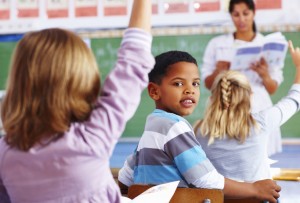
Students are better served when schools use environmentally friendly products and practice integrated pest management techniques. Â Additionally, schools can further their studentsâ education outside the classroom by providing habitat for wildlife and growing organic food in a school garden. Â By thinking green and going organic, your childâs school can become a model for the type of change thatâs occurring in communities across the nation. Beyond Pesticides has put together this back-to-school guide to help safeguard your kids from dangerous chemicals at school. Use this list to start the new school year right and ensure that you are sending your kids back to a healthier and safer environment.
Fight Germs Without Triclosan
Because of its link to adverse health effects – including asthma, cancer and learning dis Âabilities, triclosan has no place in the classroom. The American Medical Association recommends against its use in consumer products, and the FDA states that, âExisting data raise valid concerns about the [health] effects of repetitive daily human exposure to [triclosan]…â Â The EPA which also regulates this chemical has only now begun to review its registration.
The take home here is that regular soap and water is just as effective at getting rid of bacteria.
Subtract Triclosan from the Equation: Tell your principal that you are concerned about the use of antibacterial soap and its impact on the health of the students and staff. Ask that the school order regular soap from its usual janitorial product supplier and that all cleansers and sanitizers used by the school be triclosan-free. Materials on the health impacts of triclosan are available at Beyond Pesticides.
Recently students at the University of Texas passed a resolution banning triclosan soaps. You too can encourage your school to adopt an official policy that 1) commits to not procuring or using products containing triclosan or triclocarban; 2) supports efforts to educate the community about the action it has taken. Contact us for model policy language and tips on how to get started.
Itâs easy to avoid triclosan. Read the product label, whether itâs a backpack, school supplies, soap or sanitizer for any label statement that says âantibacterial,âor âantimicrobial protection.â Due to public pressure, many companies have reformulated their products without triclosan. Below are some brands that do not use triclosan:
- CleanWell
- Natureâs Gate
- Crest
- Ivory
- Dr. Bronnerâs Magic Soaps
- Purell
- Tomâs of Maine
- Listerine
- Kiss My Face
Sign the pledge and go triclosan-free.
 Donât Let DEET Get You Down
Recently, there have been recommendations that DEET, the mosquito repellent, can be used safely. But do not believe this misinformation. Studies have shown the DEET can impair muscle movement and function, learning and memory. When used together with permethrin, another ingredient commonly found in mosquito products, the risk of these effects increases.
First, the best way to protect your kids from these mosquito pesticides is to wear long pants and long sleeves, especially when mosquitoes are most active (dusk). There are other viable alternatives including:
- Oil of Lemon Eucalyptus – CDC recommends lemon eucalyptus oil repellents as a good alternative to DEET. According to CDC, this plant-based mosquito repellent provides protection time similar to low concentration DEET products.
- Picaridin (KBR 3023), dervived from pepper, also provides comparable protection as DEET products with similar concentrations.
- Essential oils – Other essential oils used in repellents include Cedarwood, Soybean Oil, Garlic Oil, and Geraniol can provide protection against mosquitoes.
For more information on keeping your family safe from mosquitoes, visit Beyond Pesticides’ mosquito management web page.
 BEE Protective
BEE Protective
Pollinators are very important to our ecosystem and agriculture. However, many pollinators, like honey bees, bumble bees, birds, and butterflies, are declining due to loss of habitat, widespread use of toxic pesticides, parasites, and disease. You and your school can play a part to help these important creatures by (1) not using toxic pesticides, (2) planting pollinator habitat, and (3) educating your friends and family. Here are some steps to BEE Protective:
– Encourage your school to plant pollinator-attractive plants in its garden as part of its biology class. If your school does not have a garden, request one be integrated into the curriculum. Wildflowers, native plant and grass species should be encouraged on school grounds. See our BEE Protective Habitat Guide for more information on attractive flowers.
– Improve your schoolâs integrated pest management (IPM) policy by encouraging staff not to use pesticides that are harmful to honey bees and other pollinators, and to apply least-toxic pesticides only when bees or other pollinators are not foraging on blooming flowers. See a list of neonicotinoid products to especially avoid.
– Have your school pass a resolution to ban neonicotinoid pesticides that are toxic to honey bees and other pollinators. A model resolution can be obtained here.If you school has pollinator-friendly habitat, pledge your school as pollinator-friendly and indicate how many acres (or fraction of an acre) your school can declare.
For more on how to BEE Protective, click here.
Keep Schools Green: Take Pesticides Out of Schools and Playgrounds
Children face unique hazards from pesticide exposure because of their small size and developing organ systems. Many school officials and groundskeepers think that the only way to ensure pests are kept at bay and good turf growth is with chemical pesticides and synthetic fertilizers. However, many schools around the country are realizing that a defined integrated pest management (IPM) program is one of the best ways to eliminate childrenâs exposure to pesticides in school buildings, and organic turf management, similarly, eliminates hazards on playing fields and playgrounds.
A good IPM is a program will have strictly defined processes of prevention, monitoring and control, as well as record keeping, which offers the opportunity to eliminate harmful pesticides in schools, where only the least toxic option is used. Improving a schoolâs pest management program requires perseverance, as administrators and grounds staff may be uninformed. One major selling point is that, when it comes to playing fields, organic turf management systems cost as much as 25% less than chemical-intensive systems.
To learn more about how to improve your schoolâs pest management policy, both indoors and outdoors, see our School Organizing guide. Learn more about the 30 of the most commonly used chemicals on athletic fields that can cause numerous health risks to children, including glyphosate (Roundup) and 2,4-D. Also see organic management of school fields in our Pesticides and Playing Fields fact sheet and the Lawns and Landscapes page.
Give Your Kids An Organic Diet Where Possible
In addition to serious health questions linked to actual residues of toxic pesticides on the food we eat, our food buying decisions support or reject hazardous agricultural practices, protection of farmworkers, and stewardship of the earth. Buying certified organic food is the only way to be sure that what you and your family eat comes from a system that rejects hazardous synthetic chemicals. There is documented evidence that children fed a pure organic diet have significantly lower levels of pesticides in their system than children fed a diet of conventionally produced food. The American Academy of Pediatricians has states that foods without pesticide residues are significant for children. Â If you are unable to eat all organic, purchase organic varieties of the foods you and your kids eat most often.
Itâs easiest to go organic when you grow organic. School gardens and other farm-to-school programs teach children where food comes from and establish healthy relationships with food and the natural world. An organic garden starts with healthy soil using natural sources of fertility such as compost, and schools have a great built-in source of potential compost feedstock in kitchen scraps and cafeteria leftovers.
You can increase the amount of organic food your child eats while decreasing his or her exposure to toxic pesticides and lessening your impact on the environment by asking your school to adopt an organic lunch program or helping to start an organic school garden. For more information, see Eating with a Conscience, Â âSchool Lunches Go Organic,â and âThe Organic School Garden.â
All unattributed positions and opinions in this piece are those of Beyond Pesticides.
Posted in Alternatives/Organics, Antibacterial, Children/Schools, DEET, Integrated and Organic Pest Management, Lawns/Landscapes, Pollinators by: Beyond Pesticides
No Comments
13
Aug
(Beyond Pesticides, August 13, 2013) Despite the defeat of Californiaâs Proposition 37 at the polls last November, itâs evident that advocates of labeling genetically engineered (GE) foods have not let the loss slow them down. In fact, Prop 37 has acted as a rallying point, lifting the issue to national attention and highlighting the GE industryâs vain attempts to quash the national grassroots movement. Recent victories with high-profile supermarkets such as Whole Foods, states including Connecticut and Maine, and the introduction of a federal GE labeling bill in both Houses of Congress set the backdrop for the biggest food fight of the year, Washington Stateâs Initiative 522 (I-522 ).
).
Washington Stateâs I-522 would require manufacturers selling foods containing GE ingredients to disclose their presence conspicuously on the front of a productâs package. The initiative comes at a critical time for the stateâs agricultural economy, particularly the apple and salmon industry, which are threatened from GE counterparts currently being considered for deregulation. Aquabountyâs GE Salmon are designed to reach maturity faster than their wild counterparts, and a Canadian company is currently waiting for approval of a GE apple that wonât brown. But the biggest threats still come from multi-billion dollar transnational agrichemical companies and grocery manufacturers. For organizing purposes, most all the detractors of GE labeling can conveniently be viewed through the membership of the umbrella groups, the Grocery Manufacturers Association and the Council for Biotechnology Information (or the umbrella groupsâ umbrella group â the âAlliance to Feed the Future.â)
Similar to Californiaâs Prop 37, I-522 is up for a public vote at election time this November, and supporters are readying themselves for another expensive fight. Last year Prop 37 supporters were outspent nearly 6:1, with opponents pouring in nearly $46 million through deceptive ad campaigns nitpicking small sections of the bill as a be-all-end-all for the Proposition. At this time last year, Beyond Pesticides reported on the big push pesticide corporations were making to block the passage of Prop 37 â at that time they had only spent $750,000; but, as we saw this was only the tip of the iceberg. A similar situation may be panning out now. As of this week the Yes on I-522 Campaign has raised nearly $2.5 million, beating out the $951,000 raised by opponents. Â Supporters will likely be outspent sooner rather than later, but that doesnât mean I-522 will go the way of Prop 37. Californiaâs fight made sure that voters in Washington State and across the country are more aware of the GE labeling issue than they were last year. Â State-level polls currently show strong support for I-522, 66% in support to only 22% opposed; and 48% âstrongly supportedâ the measure.
Washington State consumers arenât buying the oppositionâs attack strategy, as the firm that conducted the recent polling noted, âSupport for labeling withstands a barrage of opposition attacks. After voters hear one message in favor of labeling and six messages against it, support for I-522 holds at 64 percent, while opposition only increases to 29 percent.â
Concurrently, state policies and initiatives are bolstering support and keeping the pressure on federal lawmakers to pass the Genetically Engineered Foods Right-to-Know Act, simultaneously introduced into both houses of Congress by Senator Barbara Boxer (D-CA) and Representative Peter Defazio (D-OR), respectively. A recent New York Times poll shows national support for GE labeling reaching 93%, a number consistent with past polls showing broad support that cuts across race, gender, socio-economic class and party affiliation.
Labeling GE food shows strong public support because it is simply about a consumerâs inherent right-to-know the ingredients that are in the food they purchase. Large corporations fighting against labeling transparency make it seem as though they have something they need to hide.
GE food is bad for the environment. It has resulted in a legacy not of decreased pesticide use as originally claimed, but of pest and weed resistance, which has resulted in increased pesticide use. Increased pesticide use threatens wildlife, particularly sensitive species. A 2012 study found the herbicide Roundup, which is sprayed on thousands of acres of Roundup Ready corn and soybeans, to induce morphological changes in three species of frogs. GE crop-induced herbicide applications are also indirectly affecting the health of beneficial species. Widespread applications of Roundup destroy sanctuary land and the plant species that support beneficial insects and other wildlife. A recent study reported on by The Los Angeles Times in 2013 shows a record decline in monarch butterflies, which can be directly related to the widespread use of glyphosate on over 120 million acres of GE corn and soy.
Due to a lack of adequate testing, the facts arenât in whether GE food itself is safe for consumers, but we know that eating pesticide-laden food isnât. The U.S. Environmental Protection Agency recently revised the allowable residue limit of the herbicide glyphosate (the active ingredient in Roundup) in our food, despite its links to a range of diseases, including cancer, particularly non-Hodgkinâs lymphoma in three separate peer-reviewed studies (1,2,3), ADHD, rhinitis, and hormone disruption. Â The studies that have been performed on GE foods link their consumption to toxic effects, such as hepatic, pancreatic, renal, or reproductive issues that may also alter hematological, biochemical parameters. World renowned geneticist and biophysicist, and co-founder of the International Science Panel on Genetic Modification, Mae-Wan Ho, Ph.D., has cited numerous observations on the adverse impacts of GE foods, including severe inflammation of the lungs in mice, liver and kidney toxicity, damage to the organ system of young rats fed GE potatoes, and severely stunted pups.
The best way to avoid genetically engineered foods in the marketplace is to purchase foods that have the U.S. Department of Agriculture (USDA) certified organic seal. Under organic certification standards, genetically modified organisms and their byproducts are prohibited. For many other reasons, organic products are the right choice for consumers. As Washingtonâs I-522 states, âWhile total United States food sales are virtually stagnant, growing less than one percent overall, the organic food industry grew at 7.7 percent according to 2010 data. Sales of organic fruits and vegetables increased eleven and eight tenths percent, accounting for approximately twelve percent of all United States’ fruit and vegetable sales. Organic dairy, another key industry in Washington state, grew at nine percent and comprises nearly six percent of the total United States dairy market. Organic farmers are prohibited from using genetically engineered seeds or livestock feed.â
To support Washington Stateâs labeling efforts, get involved with the Yes on I-522 campaign. National GE labeling efforts are being spearheaded by the Just Label It! campaign. Â For more information on GE foods and labeling issues, see Beyond Pesticidesâ Genetic Engineering website.
All unattributed positions and opinions in this piece are those of Beyond Pesticides.
Source: The Seattle Times, Â Seattle Weekly, HeraldNet
Image Source: Yeson522.com
Posted in Agriculture, Genetic Engineering, Glyphosate, Labeling, National Politics, Washington, Wildlife/Endangered Sp. by: Beyond Pesticides
No Comments
12
Aug
(Beyond Pesticides, August 12, 2013) A recent study on triclosan, an antibacterial pesticide found in soaps, deodorants, toothpastes, cosmetics, fabrics, plastics, and toys, finds that exposure changes the composition of bacterial communities in streams and also increases bacterial resistance. The study contributes to continually mounting evidence demonstrating that triclosan is toxic to human health and the environment, even as the U.S. Environmental Protection Agency (EPA) gets ready to review the registration of the chemical.
In May, EPA initiated the registration review of triclosan, an antibacterial pesticide that has been heavily scrutinized by concerned groups, including Beyond Pesticides, as well as members of Congress. Under pressure after its 2008 review, EPA announced that it would again review triclosan in 2013, five years earlier than scheduled. Over the last few years, as a direct result of pressure from consumer groups and the media regarding the need for triclosan in consumer products and the mounting scientific evidence documenting adverse health effects, including impacts to the thyroid hormone, major manufacturers have begun to quietly reformulate their products without triclosan.
This study, published in the journal Environmental Science and Technology, took several field and artificial stream surveys, to identify the effects of triclosan on bacterial communities located on the stream beds. Antibacterial chemicals  enter streams, rivers, and lakes largely through household waste water. While municipal wastewater treatment plants remove the majority of triclosan from wastewater, low levels of the chemical still enter aquatic ecosystems. Overflowing sewage during rainy periods and sewage from old, leaking sewer pipes are other sources of triclosan that can contaminate waterways.
With these considerations in mind, researchers sought to determine how exposure to triclosan affected bacterial communities in the Chicago area. Researchers found that exposure to triclosan caused severe declines in the diversity of bacteria along the stream floor and changes to the overall community. Additionally, researchers found triclosan changed abundance of cyanobacterial sequence by almost six times, resulting in a âdramatic die off of algae.â
âIt seems that algae are a lot more sensitive to triclosan than we previously thought,â said co-author John J. Kelly, PhD., at the Department of Biology at Loyola University Chicago.  The  findings raise concern because, as Dr. Kelly says,  âThey are being used in a very high amount and little is known what its impacts are on the environment.â
These bottom dwelling bacteria are, in fact, integral to ecosystem functioning as they drive the initial degradation of organic material that is required for transforming nutrients available to plants and algae, known as ânutrient cycling.â Thus, changes to bottom-dwelling bacteria due to the contamination of antibacterials have much broader impacts to the aquatic food web.
The study provides important information on the impact of triclosan on benthic communities, particularly as a model for water systems contaminated with triclosan. Researchers in the study used a concentration that represented 15% of the highest sediment triclosan concentration ever reported in literature, which was in Baltimore. Surprisingly, âWhile we did use high doses and the bacteria responded pretty well: they didnât all die,â said Dr. Kelly. âInstead they seem to be able develop high levels of resistance,â he said.
Previous research has shown that cultured bacteria develops triclosan resistance, however, this study represents the first of its kind to link triclosan exposure and bacterial resistance in the field, raising concerns about the broad adverse impacts of antibacterials over the long term. Researchers found that, âOver the course of the five week study, the [triclosan] resistance level climbed to a maximum of 14%, suggesting that resistance levels in the field might also continue to rise if [triclosan] concentrations increase.â
When introduced to the market in 1972, triclosan was confined to hospital and health care settings. However, it has since exploded across the consumer marketplace, despite increasing research that it causes harm to human health and the environment. As an endocrine disruptor, triclosan has been shown to affect male and female reproductive hormones and possibly fetal development, and is also shown to alter thyroid function. Triclosan is not only an endocrine disruptor found at increasing concentrations in human urine and breast milk, but also contaminates waterways and possibly even drinking water. The Centers for Disease Control and Prevention (CDC) also has found that triclosan is present in the urine of 75% of the U.S. population, with concentrations that have increased by 42% since 2004. Despite industry claims, triclosan research has raised questions about its efficacy  against harmful bacteria, including those found in hospitals.
Beyond Pesticides in 2004 began voicing concern about the dangers of triclosan and in 2009 and 2010 submitted petitions to the U.S. Food and Drug Administration (FDA) and EPA, calling for the removal of triclosan from consumer products on the basis that those uses violate numerous federal statutes. Since then, many major companies are quietly removing triclosan from their products. Colgate-Palmolive, makers of SoftSoap, and GlaxoSmithKline, makers of Aquafresh and Sensodyne toothpastes,have reformulated these products to exclude triclosan, according to media reports. Others, including Johnson & Johnson, LâOreal, The Body Shop, and Staples, have started phasing it out of products.
Notably, Rep. Ed Markey (D-MA) also submitted letters of concern on the issue of triclosan to both EPA and the Food and Drug Administration (FDA). In FDAâs response, the agency acknowledged that soaps containing triclosan offer no additional benefit over regular soap and water. FDA stated that, âExisting data raise valid concerns about the [health] effects of repetitive daily human exposure to these antiseptic ingredientsâ and announced plans to address the use of triclosan in cosmetics or other products. FDA also expressed concern about the development of antibiotic resistance from using antibacterial products and about triclosanâs potential long-term health effects. Additionally, Rep. Louise M. Slaughter (D-NY) and two colleagues asked FDA to ban triclosan in 2010 due to the hazards that the chemical poses, including antibiotic resistance and potential health problems leading to higher health care costs.
Join the ban triclosan campaign and sign the pledge to stop using triclosan today. Encourage your local schools, government agencies, and local businesses to use their buying power to go triclosan-free. Urge your municipality and workplace to adopt the model resolution that commits to not procuring or using products containing triclosan.
Source: Environmental Science and Technology
All unattributed positions and opinions in this piece are those of Beyond Pesticides.
Posted in Antibacterial, Pesticide Regulation, Triclosan, Water, Wildlife/Endangered Sp. by: Beyond Pesticides
No Comments
09
Aug
(Beyond Pesticides August 9, 2013) Citrus growers in California are now turning to a natural solution after pesticides have been shown to be ineffective. Teams of invasive species experts have started releasing tamarixia radiate, a tiny parasitic wasp, to control the invasive Asian citrus psyllid population. Asian citrus psyllid can spread a disease which causes greening, devastating citrus production. This use of biological pest control demonstrates that the use of toxic chemicals is unnecessary as safer alternatives have already been proven effective.
Californiaâs citrus production is a $2 billion industr y, which accounts for 80% of the U.S. fresh market produce and after Asian citrus psyllid was detected in southern California in 2010 growers have spent close to $15 million yearly to fight this pest. The psyllids were first discovered in Florida in 1998 and has since spread to all of its 32 citrus growing counties. The United States Department of Agriculture (USDA) has quarantined nine states, including California and Florida. The quarantines prohibit interstate movement of citrus trees and require labeling of citrus nursery stocks from areas where greening has been detected.
y, which accounts for 80% of the U.S. fresh market produce and after Asian citrus psyllid was detected in southern California in 2010 growers have spent close to $15 million yearly to fight this pest. The psyllids were first discovered in Florida in 1998 and has since spread to all of its 32 citrus growing counties. The United States Department of Agriculture (USDA) has quarantined nine states, including California and Florida. The quarantines prohibit interstate movement of citrus trees and require labeling of citrus nursery stocks from areas where greening has been detected.
The psyllids cause greening by spreading a disease known as Huanglongbing (HLB) to citrus trees. A pysllid that is infected with HLB can transfer the bacterium every time it feeds on the tree. Once a tree is infected with the disease there is no known cure. HLB is one of the most severe plant diseases in the world and can affect any variety of citrus trees. Â The disease can lie dormant for several years before tests are able to detect it. In California, the disease was first detected in November 2012 and has only been found in nine counties that are south of the commercial growing areas, but because of this dormancy California commercial operations may already be infected. After trees become infected fruit from these trees is not suitable for consumer markets because of its green color, misshapen appearance, and distinctly bitter taste.
Since 2011, teams of invasive species experts have released more than 75,000 tamarixia wasps across southern California to combat the pysllids. In 2012, agricultural officials halted pesticide spraying in Los Angeles County because it proved ineffective. Six out of 10 trees in the county grow in backyards which if pesticides were used could lead to high levels of pesticide exposure for urban environments. To curb pysllids, teams of invasive species experts have been going to individual homes, releasing the wasps, and tracking the parasites success.
The wasps are imported from Pakistanâs Punjab region and extensive tests were conducted to make sure that the wasp would not disrupt other California species or become yet another invasive species. The wasps curb pysllid populations by wasps laying eggs inside the psyllid nymphâs stomach. As the eggs hatch, larvae slowly eats away at the nymph. The teams hope that after the wasps hatch they will fly to neighboring trees and lay eggs in new nymphs and establish a growing population. Even though the team is only about a year and a half into this effort, at some release sites the population of psyllids has dramatically declined. Mark Hoodle, Ph.D., an invasive species expert at UC Riverside, said to the Los Angeles Times, âWe have no other choice except to use this natural enemy or do nothing. And the ‘do nothing’ option is unacceptable.â
Beyond this recent use of tramarixia wasp, there are many other examples of effective pest management through biological controls. Last summer, several counties in New Jersey used crustaceans, which are voracious predators of mosquito larvae, to control West Nile Virus. The most effective copepod species have the capacity to kill more than 40 mosquito larvae per copepod per day, typically reduce mosquito production by 99-100%, and can maintain large populations so long as there is a reliable water source. A report in 2007 found that Muscidifurax raptor, another parasitic wasp, was effective in controlling fruit flies in vineyards. Goats have also been used across the country to weed airports, cemeteries, and to restore soil and improve land quality. The uses of biological controls are important because they prove there are alternatives to toxic pest management.
Farm operations that are USDA certified organic already avoid the use of toxic chemicals by implementing organic systems plans that can include  biological pest management. To learn more about the practices and management strategies of organic agriculture, please visit Beyond Pesticidesâ Keeping Organic Strong page.
Source/Image Source: LA Times
All unattributed positions and opinions in this piece are those of Beyond Pesticides.
Posted in Agriculture, Alternatives/Organics, California, Integrated and Organic Pest Management, State/Local by: Beyond Pesticides
1 Comment
08
Aug
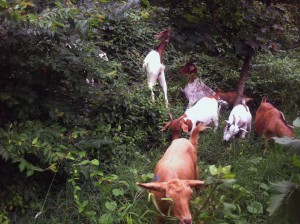
(Beyond Pesticides, August 8, 2013) Over 100 goats have been tasked with controlling poison ivy, ground cover, vines and other invasive weeds at the Congressional Cemetery this week. The Association for the Preservation of The Historic Congressional Cemetery partnered with Eco-Goats to control the invasive species that threaten large mature trees, which can fall and damage headstones. In addition to their weed-managing services, the goats provide free fertilizer, aerate the soil with their hooves, and eliminate the need for chemicals. Â The goats, penned outside of the burial area of nearly 200 members of Congress, J. Edgar Hoover and other notable Washingtonians, will graze 24 hours a day for the next several days to control weeds along the perimeter of the cemetery.
At a press event held Wednesday at the cemetery, Paul Williams, president of the Association explained that the goats are being used as an eco-friendly and cost-efficient alternative to machines or pesticide, considering the cemetery rests on the banks of the Anacostia River. (See information on pesticides and waterways.)
Brian Knox, president of President of Sustainable Resource Management, Inc. and the supervising forester for Eco-Goats explained at the press event (pictured left) that goats act as broad-spectrum weed killers; they will eat everything. In fact, goats are often more efficient at eradicating weeds, and are more environmentally sustainable than using harmful pesticides and chemicals. Once goats graze a weed it cannot go to seed because it has no flower and cannot photosynthesize to take in sunlight and build a root system because it has no leaves. Grasses are a last choice for goats, which means the desirable grass species are left behind with natural fertilizer to repopulate the land. Goats are notorious for eating poisonous plants, such as poison ivy and poison oak, and can handle them without getting sick.
Though this is the first time goats will be used in Washington, D.C. to control weeds, goat grazing is a growing movement throughout the nation. Communities across the nation, from California to Colorado to Chicago, have discovered that grazing goats is a great option for land that suffers from unwanted plants, low organic matter and soil compaction.
Beyond Pesticides has long been an advocate for the use of goats and grazing animals as a least-toxic solution for weed management. To learn more, read âSuccessfully Controlling Noxious Weeds with Goats: The natural choice that manages weeds and builds soil health.â Watch Beyond Pesticides’ Board Member Lani Malmberg, a professional goat herder and owner of Ewe4ic Ecological Services, speak at the 31st National Pesticide Conference along with other experts on the Organic Land Mangement and Cutting Edge Alternatives panel. For more information on natural, non-chemical land management strategies see Beyond Pesticidesâ Lawns and Landscapes and Invasive Weed Management pages.
Goats at the Congressional Cemetery, which is open from dawn to dusk daily, are available to view from now until August 12.
All unattributed positions and opinions in this piece are those of Beyond Pesticides.
Photos by Beyond Pesticides.


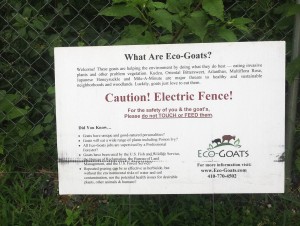
Posted in Alternatives/Organics, Lawns/Landscapes by: Beyond Pesticides
4 Comments
07
Aug
(Beyond Pesticides, August 7, 2013) California’s Department of Pesticide Regulation (DPR) has detected the highly toxic pesticide chlorpyrifos in nearly 30% of air tests that are being conducted in three high risk communities surrounded by intensive agriculture. This result is part of DPR’s  2012 results from its  air-monitoring network (AMN)  sampling near the towns of  Ripon, Salinas and Shafter, in Kern County.  The state has been running tests for air particles from methyl bromide and 32 other pesticides and breakdown products and measuring the results against screening levels established by DPR. No state or federal agency has set health standards for pesticides in air. While the state believes the levels found present an acceptable risk, critics maintain that the state’s sampling is not representative of peak agricultural exposures and question whether any level of a toxicant in air is reasonable under the law, given the viability of alternative agricultural practices that do not rely on these chemicals.
 DPR said no residues were detected in 94.5 percent of the samples it collected, and the levels in the rest were well below thresholds for protecting people from pesticide-related illnesses. The communities in the study were selected from a list of 226 communities in the state based on pesticide use on surrounding farmland and demographics, including the percentage of children, the elderly and farm workers in the local population. In response to the results, DPF’s Director, Brian Leahy said, “This is reassuring news for residents.â He continued, Â âOur monitoring in 2012 shows that none of the pesticides exceeded their screening levels, indicating a low health risk to the people in these communities. These findings indicate that the state and county restrictions are keeping air concentrations below the health protective targets set by DPR.â
DPR said no residues were detected in 94.5 percent of the samples it collected, and the levels in the rest were well below thresholds for protecting people from pesticide-related illnesses. The communities in the study were selected from a list of 226 communities in the state based on pesticide use on surrounding farmland and demographics, including the percentage of children, the elderly and farm workers in the local population. In response to the results, DPF’s Director, Brian Leahy said, “This is reassuring news for residents.â He continued, Â âOur monitoring in 2012 shows that none of the pesticides exceeded their screening levels, indicating a low health risk to the people in these communities. These findings indicate that the state and county restrictions are keeping air concentrations below the health protective targets set by DPR.â
However, Pesticide Action Network (PAN), based in California, raises doubts about DPRâs results. PAN also monitors airborne pesticide residues with its “drift catcher” device and finds levels that put children at risk. PAN believes that DPR sampling was not representative of real agricultural exposures – during and after pesticide application. “DPR sampled in a systematic but not targeted manner, with samples being taken once per week for 12 months,” PAN staff scientist Emily Marquez said. “The most important time to monitor is during the times of peak use.”
A 2010 PAN report  revealed that fumigant pesticides, like chloropicrin, contaminated half of the 57 air samples collected, with average levels of exposure over the 19-day period at 23 to 151 times higher than acceptable cancer risks. Earlier this year, DPR proposed restrictions on the use of chloropicrin, commonly applied to strawberries, peppers, tomatoes, raspberries, and blackberries. The proposed rule would not only increase buffer zones around application sites, but also restrict application acreage, impose notification requirements, enhance emergency preparedness requirements, and prolong the time that chloropicrin-applied fields must remain covered.
Fumigants are highly volatile and prone to drift, with severe implications for human health. Some of the health effects linked to exposure can include headaches, vomiting, severe lung irritation, and neurological effects. Some fumigants are linked to cancer, reduced fertility, birth defects and higher rates of miscarriage.
The pesticides detected the most often were chlorpyrifos and MITC, found at all three locations 28 percent of the time. Pesticides can drift and volatilize, and move over long distances fairly rapidly through wind and rain. Documented exposure patterns result from drift cause particular concerns for children and other sensitive population groups. Adverse health effects, such as nausea, dizziness, respiratory problems, headaches, rashes, and mental disorientation, may appear even when a pesticide is applied according to label directions. DPRâs AMN samples ambient air for multiple pesticides on a regular schedule to expand DPRâs knowledge of the potential health risks of long-term exposure to pesticides and more accurate estimates of health risks based on long-term exposure rather than extrapolation from short-term monitoring data to help them determine if additional protective measures are needed.
Farmers, farmworkers, their families and those living in close proximity to agricultural fields face disproportionate pesticide risks. An average of 57.6 out of every 100,000 agricultural workers experience acute pesticide poisoning, illness or injury each year, the same order of magnitude as the annual incidence rate of breast cancer in the United States. The federal government estimates that there are 10,000-20,000 acute pesticide poisonings among workers in the agricultural industry annually, a figure that likely understates the actual number of acute poisonings. Just last month, farmworkers from across the nation called for stronger protections for farmworkers from hazardous pesticides.
The best way for consumers to prevent use  of hazardous fumigants and other pesticides is to buy organically produced food. Support organic farming and protect farmers, farmworkers, and their families and neighbors from toxic chemicals. Organic agriculture does not allow the use toxic chemicals that have been shown to drift and cause a myriad of chronic health effects, such as cancer, endocrine disruption and a series of degenerative diseases like Parkinsonâs disease. To learn more about organic agriculture please visit Beyond Pesticides organic agriculture page.  For more information on organic versus conventional agricultural practices, see Beyond Pesticidesâ guide, Organic Food: Eating with a Conscience, urging consumers to consider impacts on the environment, farmworker and farm familiesâ health âin addition to personal health impacts posed by pesticide residuesâ when making food choices.
For background on pesticide drift issues, see Getting the Drift on Chemical Trespass  and National Institute of Occupational Safety and Health study.
DPR is accepting comments on this draft report until September 20, 2013. Â Please submit comments in writing to: Edgar Vidrio, Department of Pesticide Regulation, Environmental Monitoring Branch, PO Box 4015, Sacramento, CA, 95812-4015, or email: [email protected].
Sources: CDPR, Santa Maria Times
Image Source: ucanr.edu
Posted in California, Chemicals, chloropicrin, Chlorpyrifos, methyl bromide, Pesticide Drift, State/Local by: Beyond Pesticides
4 Comments
06
Aug
(Beyond Pesticides, August 6, 2013) On August 1, as President Obama signed an Executive Order, entitled Improving Chemical Facility Safety and Security,  intended to improve chemical facility safety and security, a coalition of labor and environmental groups delivered a letter to newly appointed Environmental Protection Agency (EPA) Administrator Gina McCarthy, urging her to make chemical disaster prevention one of the priority initiatives  in her first 100 days in office. The letter and Executive Order come nearly  four months after an explosion at a chemical plant in West, Texas claimed the lives of 14 people and injured hundreds more.
 The letter from labor and environmental groups shows that there is broad support for the only fool-proof way to prevent chemical disasters, namely switching to safer chemical processes. In the letter, groups encourage the Obama Administration to follow through on the Presidentâs 2008 campaign platform, where he promised to âsecure our chemical plants by setting a clear set of federal regulations that all plants must follow, including improving barriers, containment, mitigation and safety training, and wherever possible, using safer technology, such as less toxic chemicals.â Groups argue that EPA already has the authority under the Clean Air Act (CAA). After the 9/11 attacks, EPA proposed using CAAâs disaster prevention authority to make chemical facilities âinherently safer by reducing the quantities of hazardous chemicals handled or stored, substituting less hazardous chemicals for extremely hazardous ones, or otherwise modifying the design of processes to reduce or eliminate chemical hazards.â The letter notes that the Bush Administration tragically scuttled this plan of action.
The letter from labor and environmental groups shows that there is broad support for the only fool-proof way to prevent chemical disasters, namely switching to safer chemical processes. In the letter, groups encourage the Obama Administration to follow through on the Presidentâs 2008 campaign platform, where he promised to âsecure our chemical plants by setting a clear set of federal regulations that all plants must follow, including improving barriers, containment, mitigation and safety training, and wherever possible, using safer technology, such as less toxic chemicals.â Groups argue that EPA already has the authority under the Clean Air Act (CAA). After the 9/11 attacks, EPA proposed using CAAâs disaster prevention authority to make chemical facilities âinherently safer by reducing the quantities of hazardous chemicals handled or stored, substituting less hazardous chemicals for extremely hazardous ones, or otherwise modifying the design of processes to reduce or eliminate chemical hazards.â The letter notes that the Bush Administration tragically scuttled this plan of action.
President Obamaâs Executive Order moves the country closer toward safer chemical processes by creating a number of deadlines that cabinet members and agency heads must meet to update guidance, outreach, standards, and regulations concerning the storage and handling of hazardous chemicals. Senator Barbara Boxer, chairwoman of the U.S. Senateâs Environment and Public Works Committee, praised the Presidentâs role in this issue saying, âFor me, itâs a game-changer. I saw the intransigence of some of the agencies. I saw them arguing and not committing. . .We asked the President to help make sure this never happens again.â Â Though there is much to be pleased with in the Presidentâs Executive Order, some are wary that creating a working group will not lead to substantive change. Representative Bill Flores (TX-R), whose district includes West, Texas, noted, âWhat the President laid out is the right thing to do, except the working group. It reminds me of committees. Committees go out and they study things for a while. They produce a nice report, and nothing gets done. What we need are actions.â
Environmental groups question whether the Executive Order is forceful enough, and if the order will have any impact beyond the federal level, as state and local regulators are critically important to providing safeguards from chemical disasters. Ultimately, time will tell if the Presidentâs order will turn into real action. Rick Hind, legislative director at Greenpeace notes, âItâs a process that could be very fruitful and the key test will be in 90 days when they issue the policy options. You canât completely prevent a chemical disaster unless you use a safer alternative. [EPA] has clear authority to issue new rules and safety standards.â
The disaster in West, Texas exposed the deficiencies in the regulation of chemical facilities. Oversight may be comprised of over 10 agencies at the federal and state levels, and information sharing is often limited, allowing important information to fall through the cracks. Laws correcting these problems have been repeatedly shot down by industry lobbying in recent years. In 2012, the chemical and manufacturing industry doubled its spending on lobbying to over $55 million.
Many groups, including Beyond Pesticides, have focused on encouraging safer alternatives in chemical processing since before the tragic events that occurred in Bhopal, India in 1984 by Union Carbide, now a wholly owned subsidiary of Dow Chemical (which was recently issued a summons over the events). Given the past support the President, Vice President and some at EPA and in Congress have voiced for ensuring that chemical facilities use the safest processes available, this may be a once in a generation moment to realize these policies. That success will not only prevent disaster but will also create down stream opportunities for pollution prevention, green chemistry and clean production.
Source: Dallas News, Bloomberg BNA
Image Source: Mother Jones
All unattributed positions and opinions in this piece are those of Beyond Pesticides.
Posted in National Politics, State/Local, Texas by: Beyond Pesticides
No Comments
05
Aug
(Beyond Pesticides, August 5, 2013) Nine state Attorneys General sent a letter to the Senate Environment and Public Works Committee last week expressing their âdeep concerns about unduly broad preemption language proposed in S.1009, the Chemical Safety Improvement Act [CSIA].â CSIA would amend the decades old (1976) U.S. chemical law, the Toxic Substances Control Act (TSCA), which in its current form requires absolutely no testing on chemicals (it does not cover pesticides) before they make their way onto the market. Manufacturers are only required to provide the U.S. Environmental Prote ction Agency (EPA) with  90 days premarket notification before a new chemical is introduced for public consumption. Even after entering the market, the testing and regulation thresholds for these chemicals are grossly inadequate. In the 37 years that TSCA has been in effect, only 200 of the 85,000 industrial chemicals that have ever been in use have been tested or regulated.
ction Agency (EPA) with  90 days premarket notification before a new chemical is introduced for public consumption. Even after entering the market, the testing and regulation thresholds for these chemicals are grossly inadequate. In the 37 years that TSCA has been in effect, only 200 of the 85,000 industrial chemicals that have ever been in use have been tested or regulated.
Many states have not waited for Congress to update these scant protections, opting instead for state reforms to address the potential risks of toxic substances. CSIA endangers the ability for states to enforce these laws, the Attorneys General letter says, explaining that, âReforms that come at the cost of sweeping preemption of state authority âas in S.1009â do not advance the protection of our citizensâ health and the environment.â
The proposed law would prohibit judicial review of EPAâs designation of a chemical as âhighâ or âlow priority.â In a dizzying catch-22, states would be unable both to challenge in court EPA’s designation of a chemical, and adopt and enforce new laws regulating these chemicals.  CSIA would prevent states from regulating chemicals months or even years before a single protective federal regulation becomes effective. This would leave an enormous safety gap  -exposing human health and the environment to undue harm.
Under current TSCA provisions, after EPA has regulated a chemical states may adopt new laws or enforce existing laws regulating the same chemical without a waiver in many cases. The proposed legislation  would eliminate many waiver-free regulatory paths for states â for example by preventing states from banning any chemical that EPA has already regulated. And, if states were to seek a waiver to allow them to enact regulations stricter than those imposed by EPA, under the new law they would be required to certify a âcompelling local interestâ; a phrase which state Attorneys General criticize as unclear and may create a complete barrier to state action.
In 2011, the first version of a TSCA reform bill, titled the Safe Chemicals Act, was introduced by the late Senator Frank Lautenberg. That bill would have instituted a risk assessment methodology, similar to the one used on pesticides today, which, in theory, requires chemical companies to prove that their products are âsafeâ for human health and the environment before allowed into commerce. Beyond Pesticides has long criticized the risk assessment methodology used by EPA under pesticide law, Â encouraging an alternatives assessment which creates a regulatory trigger to adopt alternatives and drive the market to go green. However, even the weaker risk assessment methodology in Senator Lautenbergâs Safe Chemicals Act had a tough time moving through Congress. In response, Senator Lautenberg, a Democrat, joined with Senator David Vitter (R-LA) to introduce CSIA earlier this year. But this law is being heavily criticized by states and environmental groups. States are concerned about the preemption issues discussed above, while environmental groups note that there would be little or no testing before a chemical is brought on to the market, no mandatory time table to regulate existing chemicals, and expansive provisions to curb the ability of individuals to pursue litigation in the form of toxic torts.
TSCA is a weak environmental law and, though supporters point to improvements, critics say  CSIA would in fact scuttle the laws that states have enacted to fill the gaps left by federal regulators concerning human health and environmental protection. The history of federal environmental laws shows time and time again the importance of state authority to adopt more stringent standards to both fill gaps left by federal regulators and to encourage broader federal action to be more protective. As the Attorneys General letter states, âUniformity of regulation should not be achieved by sacrificing citizensâ health and the environment… Innovative state laws often result in better regulation and more safeguards, particularly for vulnerable subpopulations such as children and pregnant women. State initiatives have served as templates for national standards.â
Lobbying for preemption laws is a tried and true practice of the chemical industry. Beyond Pesticides continues to fight against these restrictive policies, at both the state and federal level, which prevent localities from enacting important protections for citizens and the environment. In 2011, the Connecticut legislature introduced a bill to overturn the stateâs preemption law governing pesticide use. In 2005, a landmark Supreme Court case, Bates vs. Dow Agrosciences LLC, affirmed the rights of private individuals to sue pesticide manufactures despite manufacturers claim that EPAâs pesticide labeling process under  Federal Insecticide Fungicide and Rodenticide Act ensured the safety of their products. CSIA represents the latest industry-fueled overreach into localities’ and states’ ability to regulate toxic chemicals to protect their citizens and the environment.
Environmental Working Groupâs Ken Cook in an interview with BillMoyer.comâs Theresa Riley summarized the impending negotiations well, explaining, âThe silver lining here is that the industry has savagely attacked Frank Lautenbergâs bill for eight years, his previous efforts, but never offered anything in legislative language of its own. Now we have it. We see what industry really wants, and now the debate can really begin. There are going to be some fireworks. I donât know if thereâll be legislation in the end that moves very far, but in that sense, itâs been a service to the debate to have this bill introduced, because now we know what weâre up against, what the strategy at least initially was, what they hope to get and what their priorities are. And weâll see how far compromise can go when David Vitter is the one who has to approve all the amendments.â
Source: LA Times, BillMoyers.com
All unattributed positions and opinions in this piece are those of Beyond Pesticides.
Posted in National Politics, Pesticide Regulation, State/Local by: Beyond Pesticides
No Comments
02
Aug
(Beyond Pesticides, August, 2, 2013) A new study published in the American Journal of Epidemiology concludes that farmers using herbicides are nearly two and a half times as likely to be treated for depression as those who did not use herbicides. Furthermore, farmers who are exposed for greater periods of time are also afflicted with greater risk of developing depression, raising concerns of the harm chemicals can cause to mental health. Building on substantial research supporting the link between pesticide exposure and neurological damage, this study examines the role that pesticides play in the overall health of farmers, and gives further weight to the importance of choosing organic food.
Researchers surveyed 567 farmers from France, questioning them on the frequency of their use of fungicides, insecticides, and herbicides, to determine how pesticide exposures were linked to the risk of developing clinical depression. Lead researchers and associate professor at the Harvard School of Public Health, Marc Weisskopf, PhD, said while the results are unclear, they âsuggest we should not be ignoring herbicides just because they’re targeting plants.”
Previous research has already suggested that pesticides, particularly organophosphates, cause a variety of serious neurological health problems, including Parkinsonâs disease. This is not surprising, as organophosphates are known to be extremely toxic to nerve cells and deadly at large doses. Recently, organophosphate pesticides caused the deaths of 25 children in India from contaminated school lunches.
To determine chemical exposures, researchers conducted interviews, surveyed old pesticide containers, and even examined records for pesticide purchases. Beyond those measures, researchers also asked whether farmers had ever been treated for depression. The results of the study showed that of 567 farmers 83 of them self-reported treatment or hospitalization for depression, almost 15 percent. After adjusting for age and health factors like smoking, the study found that farmers that use herbicides were more than twice as likely to have been treated for depression. Similarly, those farmers who were exposed to herbicides for a greater length of timeââeither more hours of exposure or for a greater number of yearsââwere also more likely to be treated for depression than those with less exposure.
Interestingly, the study found no difference in the risk of developing depression between farmers that had fungicides or insecticides compared to those that had not. Dr. Weisskopf posited that this may be because farmers are more aware of the harm fungicides and insecticides have on human health. “If (herbicides) are considered in general safer and people take less precautions because people think they’re not as bad, then that poses a problem,” he told Reuters.
While the study provides important insight into the effect of pesticides on mental health, it does not definitively prove cause and effect. Researchers accounted for age and cigarette smoking in their correlation, however there may be other health conditions or external circumstances not accounted for in the study that changed work conditions and/or made them susceptible to depression.
However, scientists not involved in the study, such as Cheryl Beseler, PhD. and researcher at Colorado State University, have supported the work and stand behind the strength of the studyâs methodology. Dr. Weisskopf confirmed that “This still has to be considered a relatively first, small study. There’s more work to do, but it raises concerns that need to be looked into more fully.”
Through our  Pesticide Induced Diseases Database (PIDD), Beyond Pesticides keeps track of the most recent studies related to pesticide exposure. For more information on the multiple harms pesticides can cause, see our PIDD pages on Alzheimerâs, Parkinsonâs, cancer, and other diseases.
Studies such as these, highlights the importance of buying, growing, and supporting organic. Consumers choices encourage the protection of the people who help put food on our table every day by purchasing organic. By buying organic, you support an agricultural system that does not heavily rely on the widespread application of dangerous pesticides. For more information on how organic is the right choice for both consumers and the farmworkers that grow our food, see Beyond Pesticides webpage, Health Benefits of Organic Agriculture.
Source: American Journal of Epidemiology, Reuters
All unattributed positions and opinions in this piece are those of Beyond Pesticides.
Posted in Agriculture, Disease/Health Effects, Farmworkers, International by: Beyond Pesticides
No Comments





































